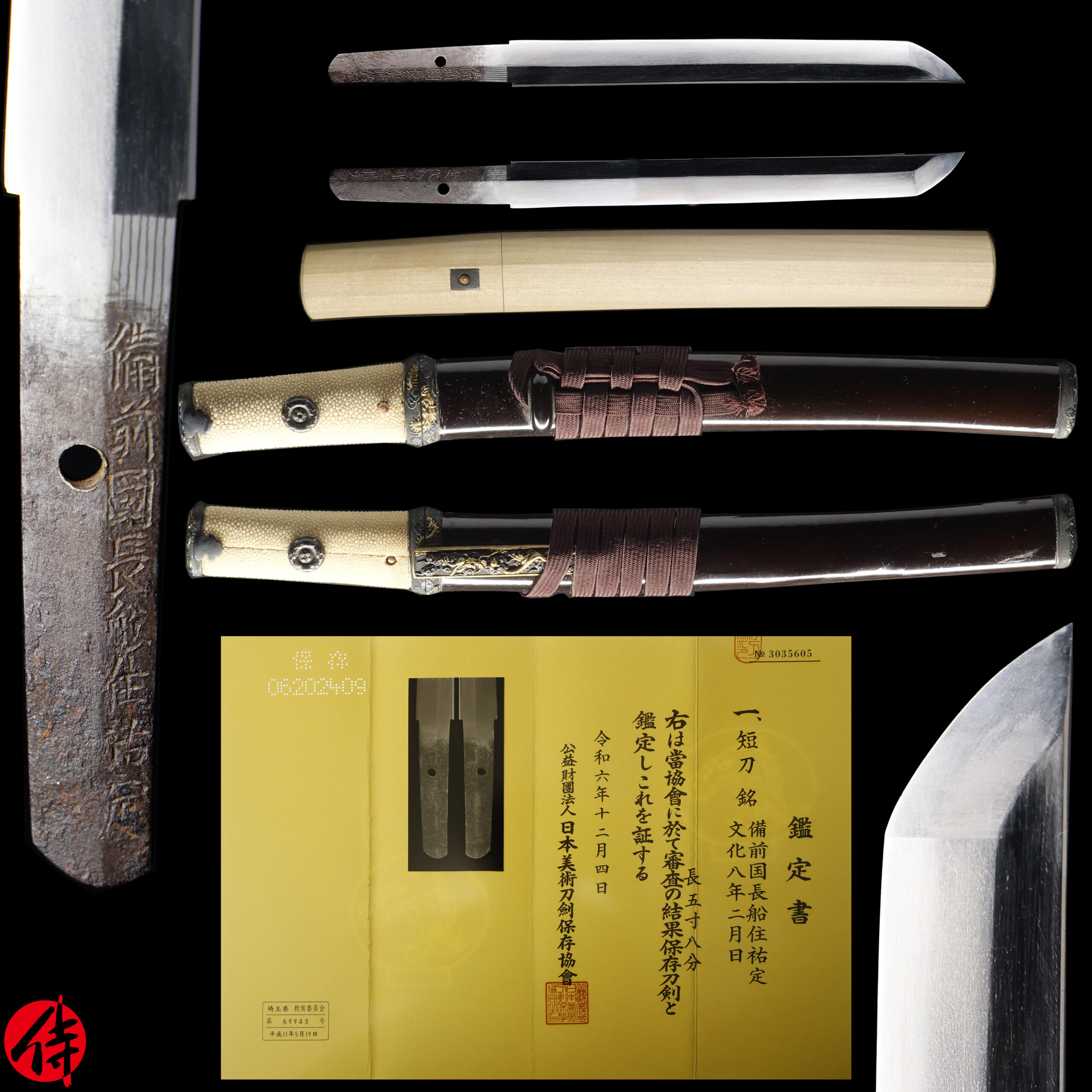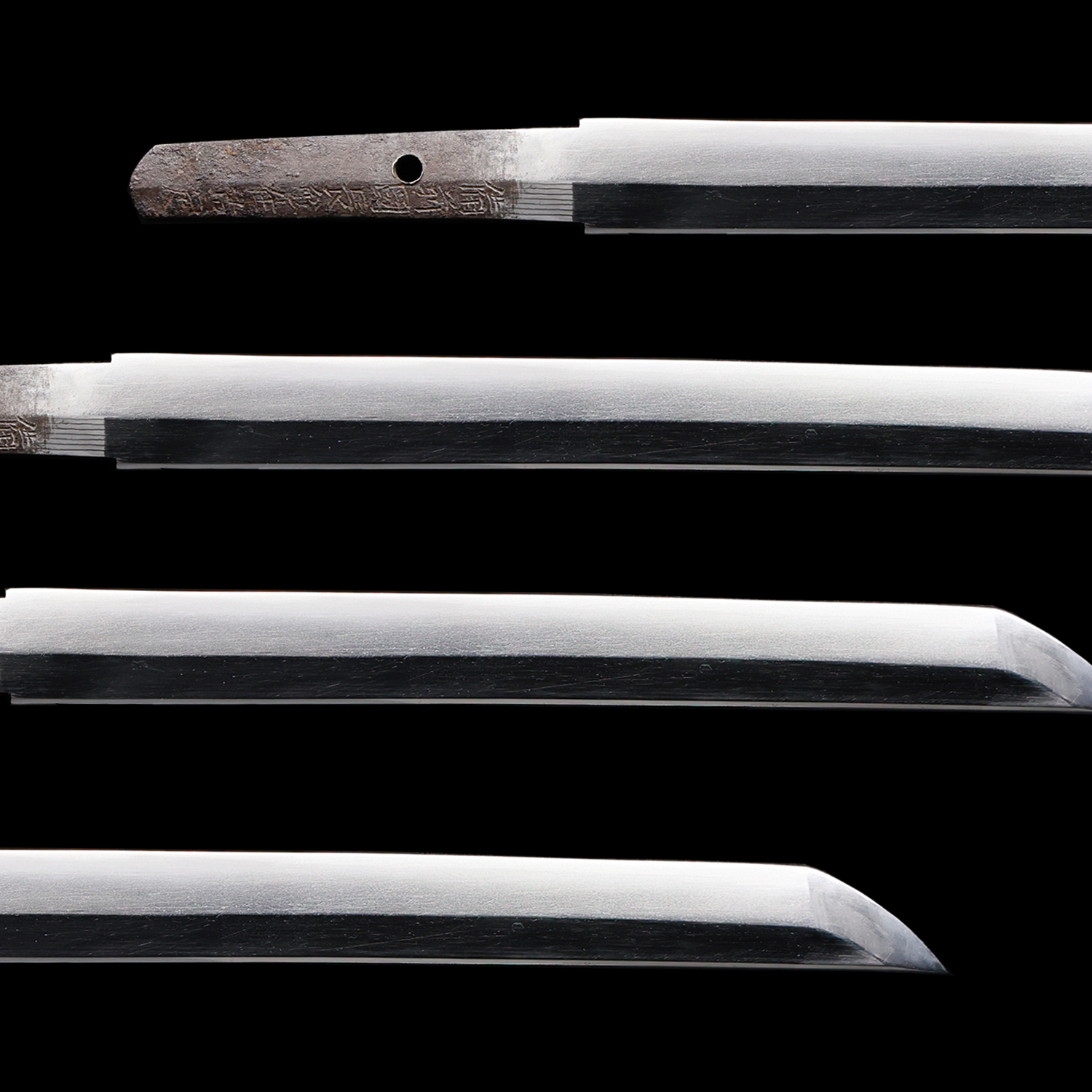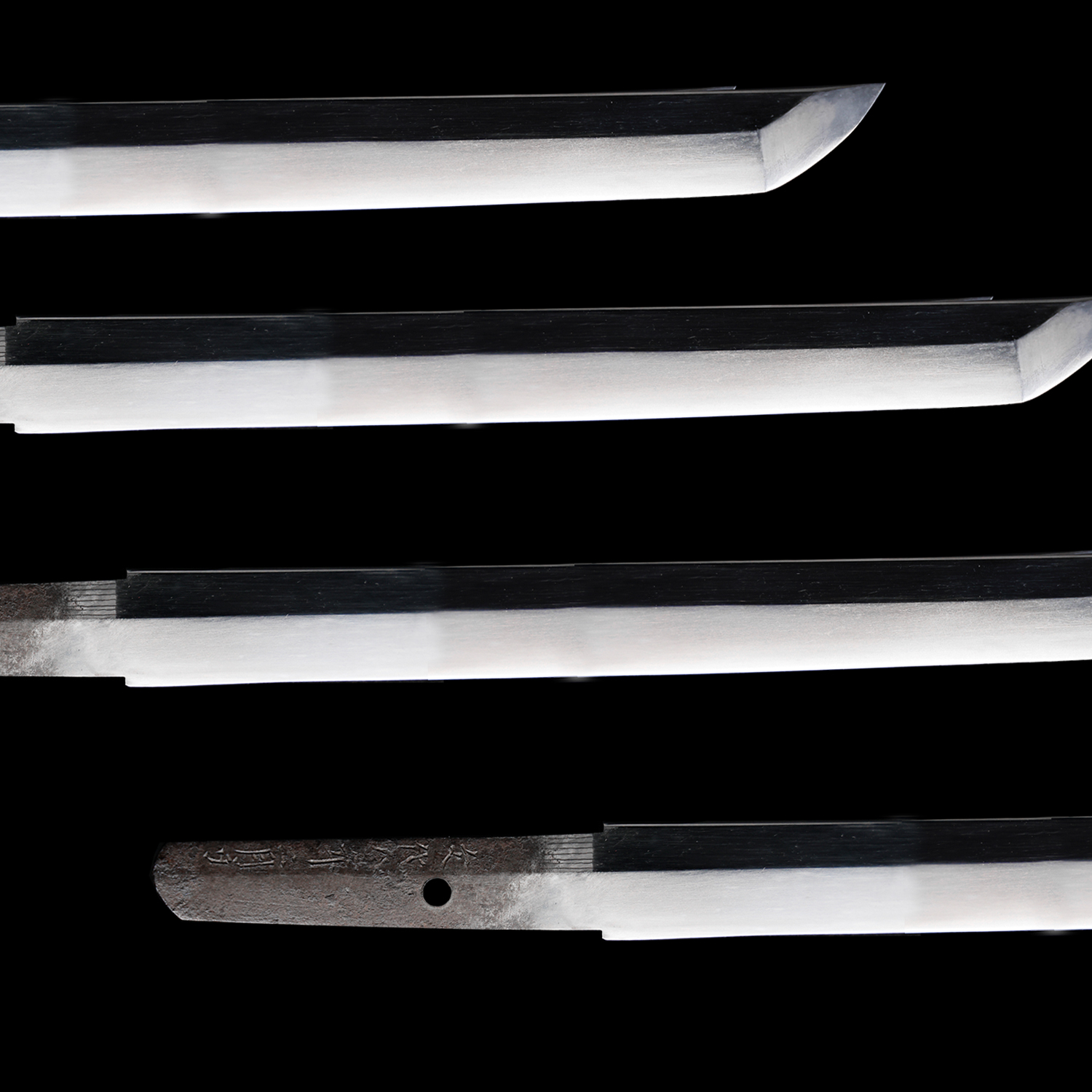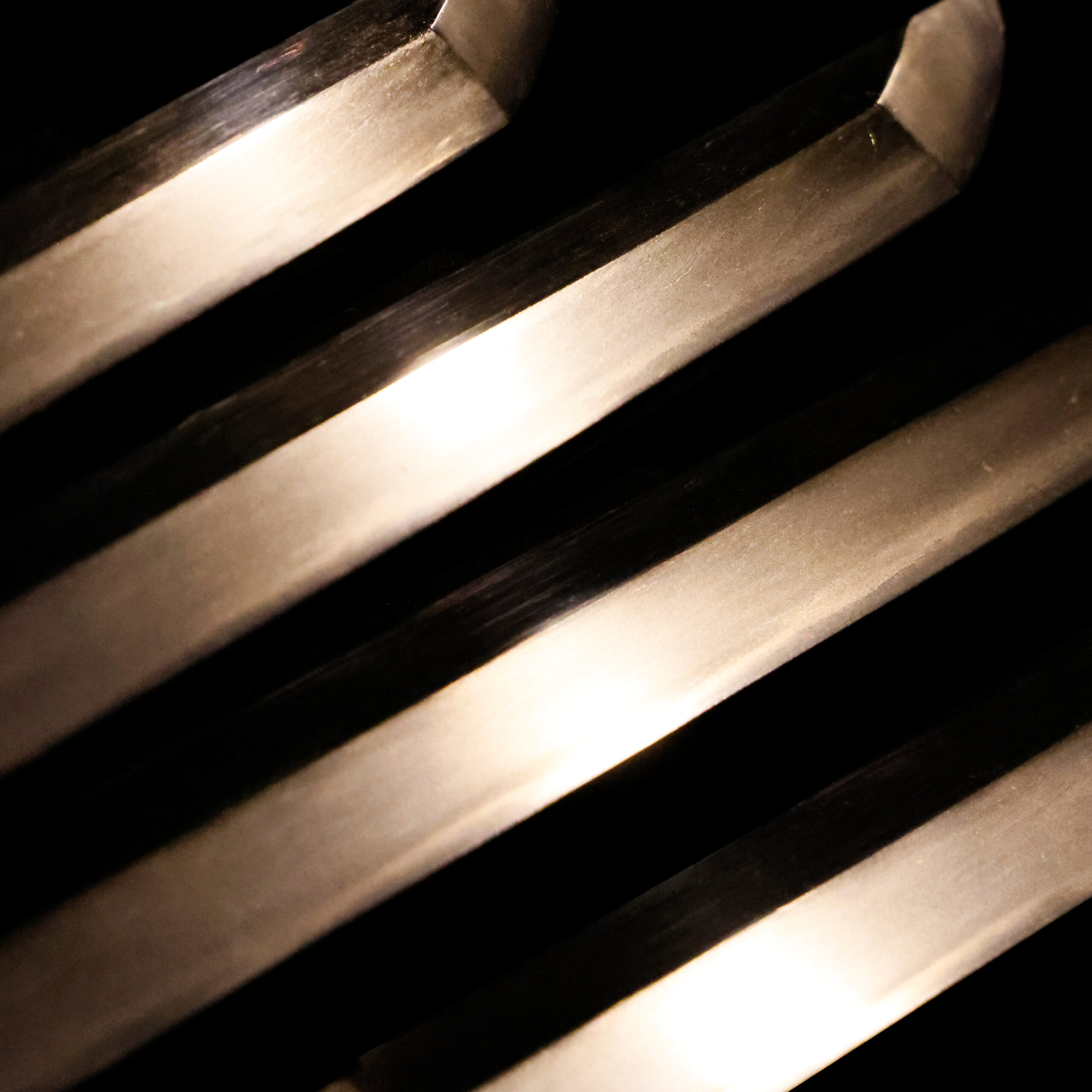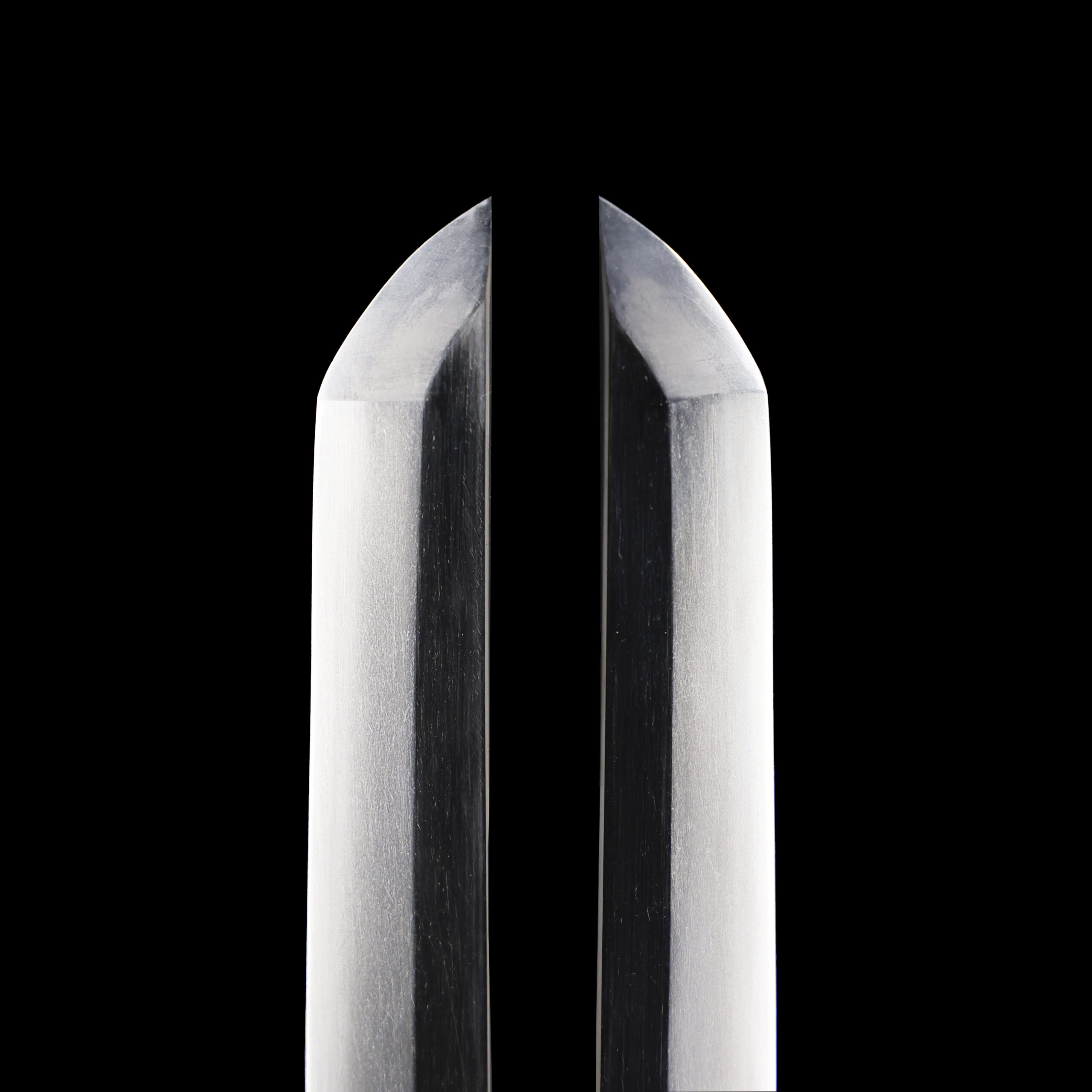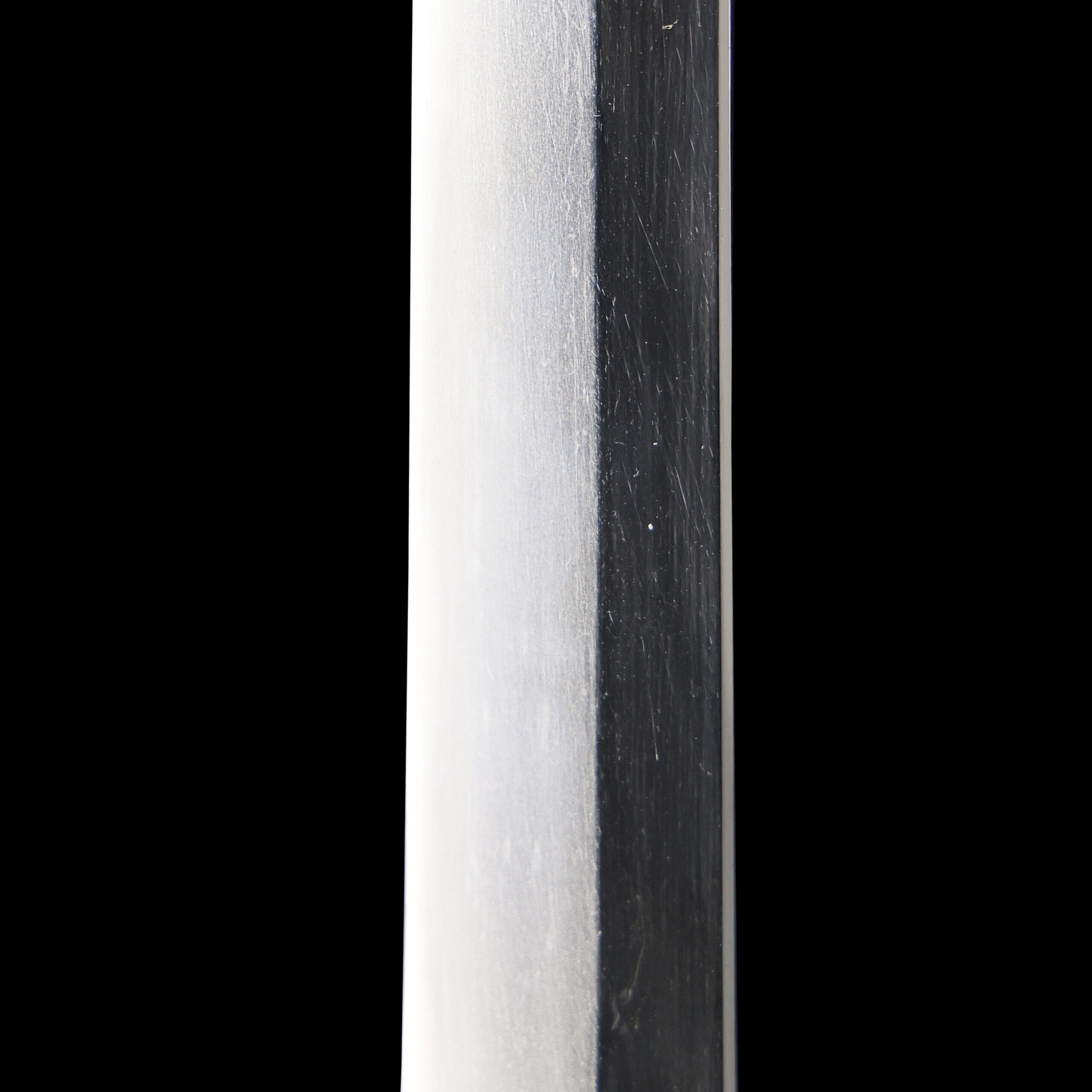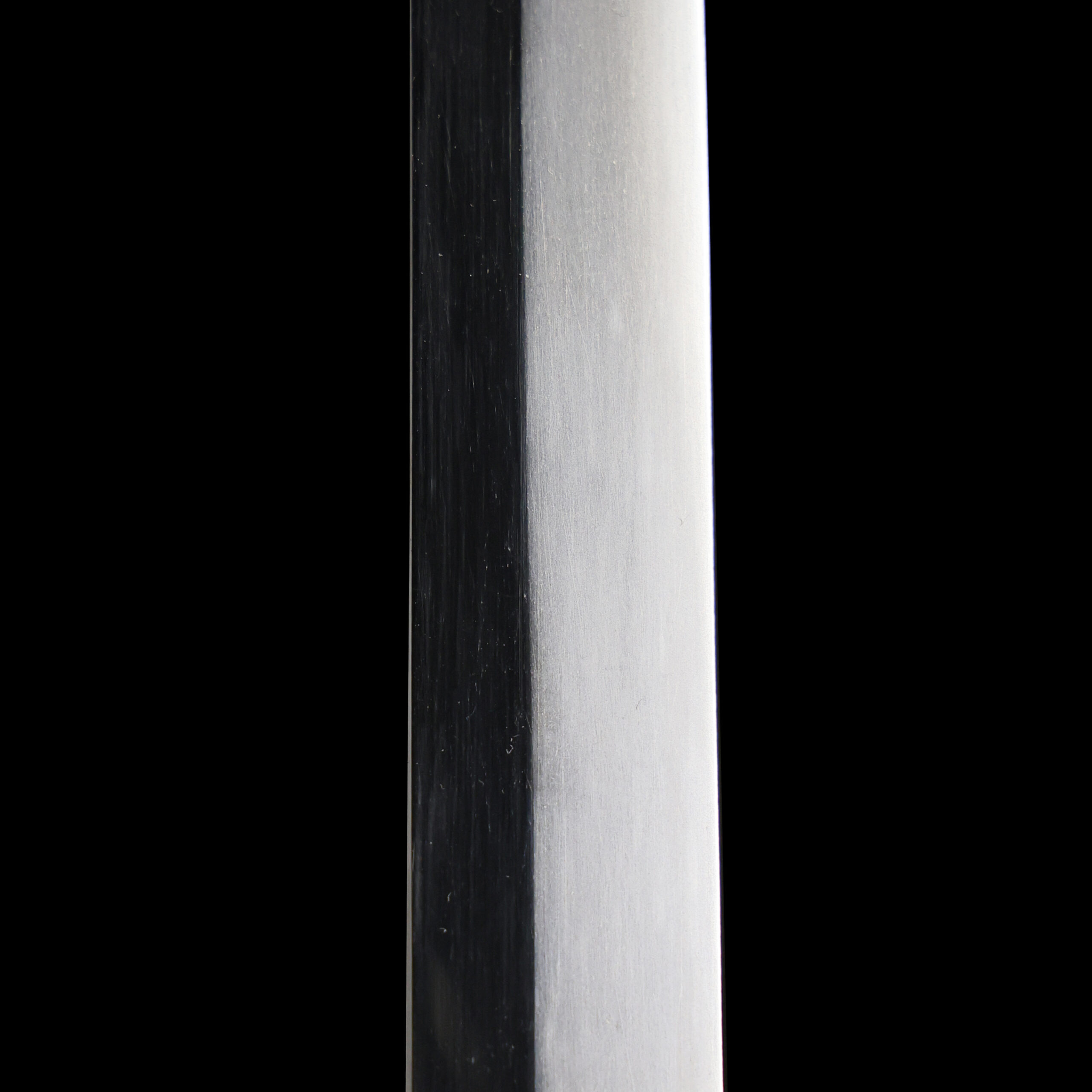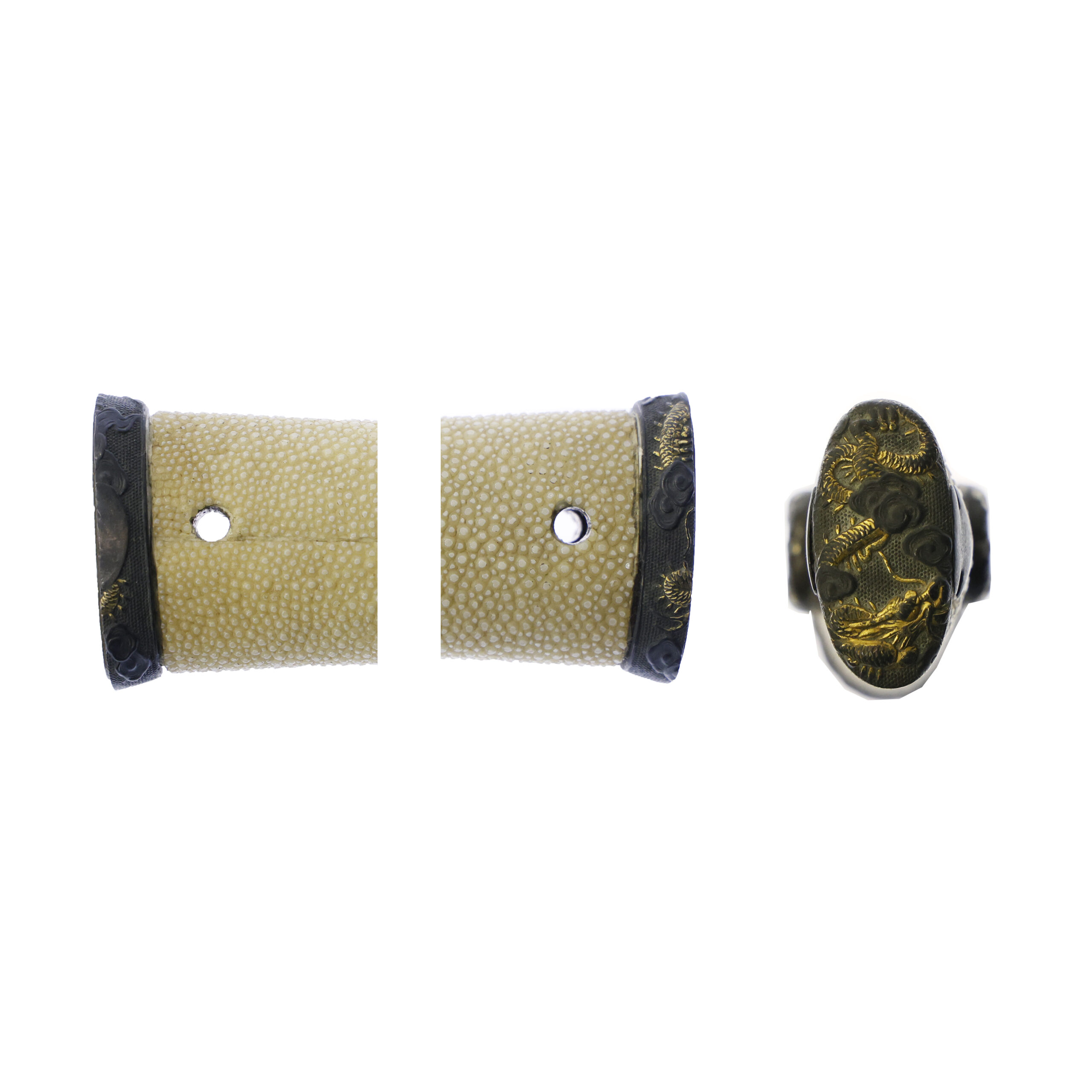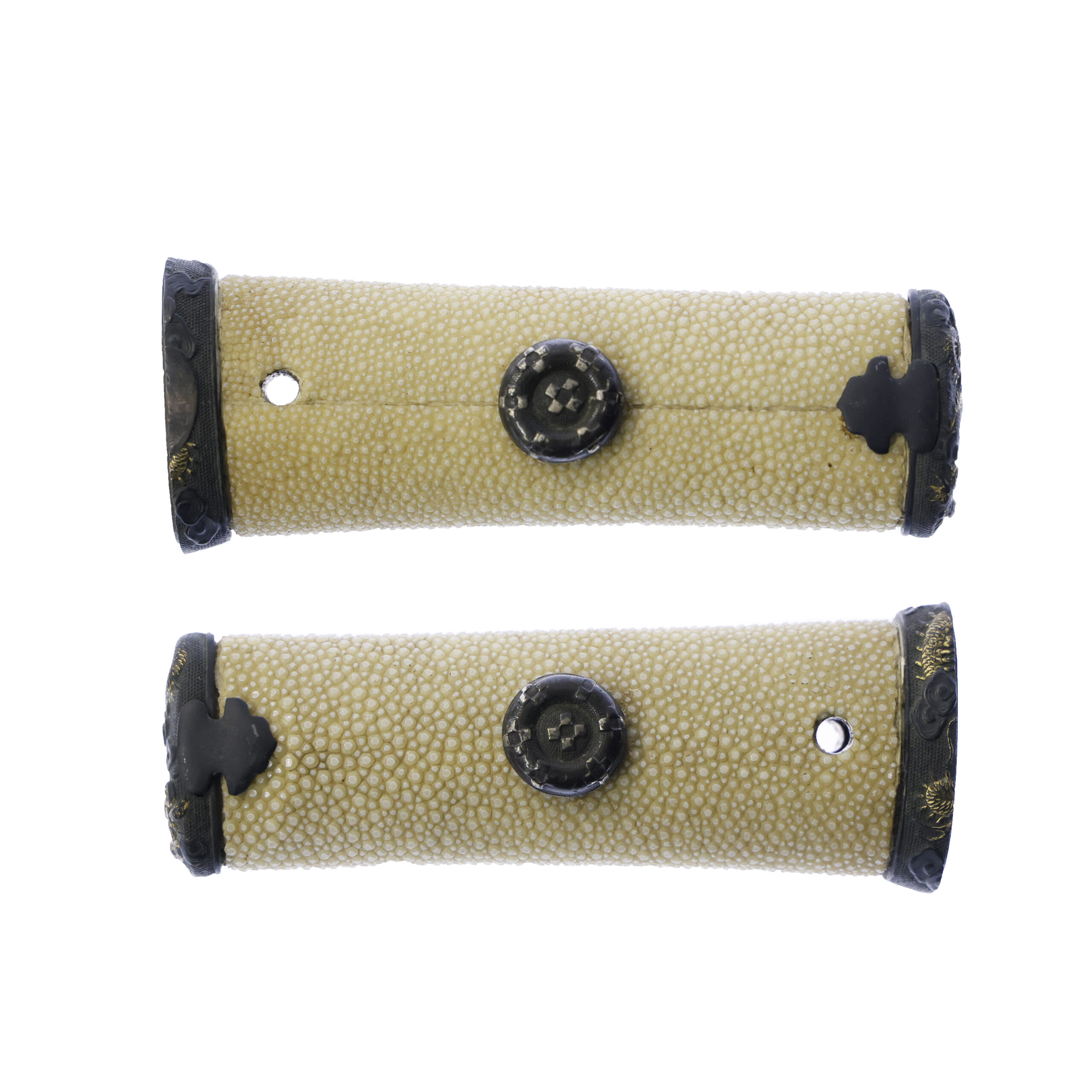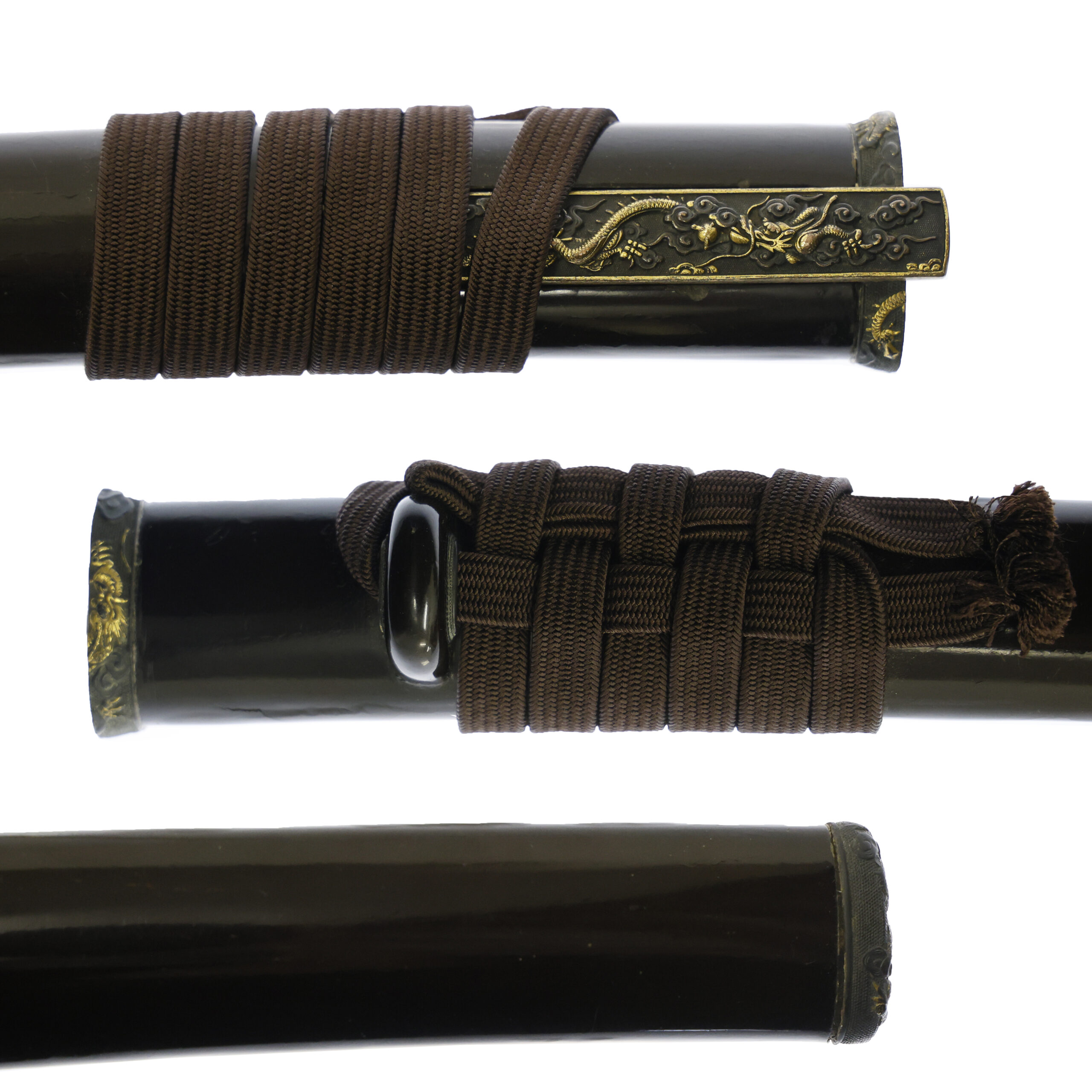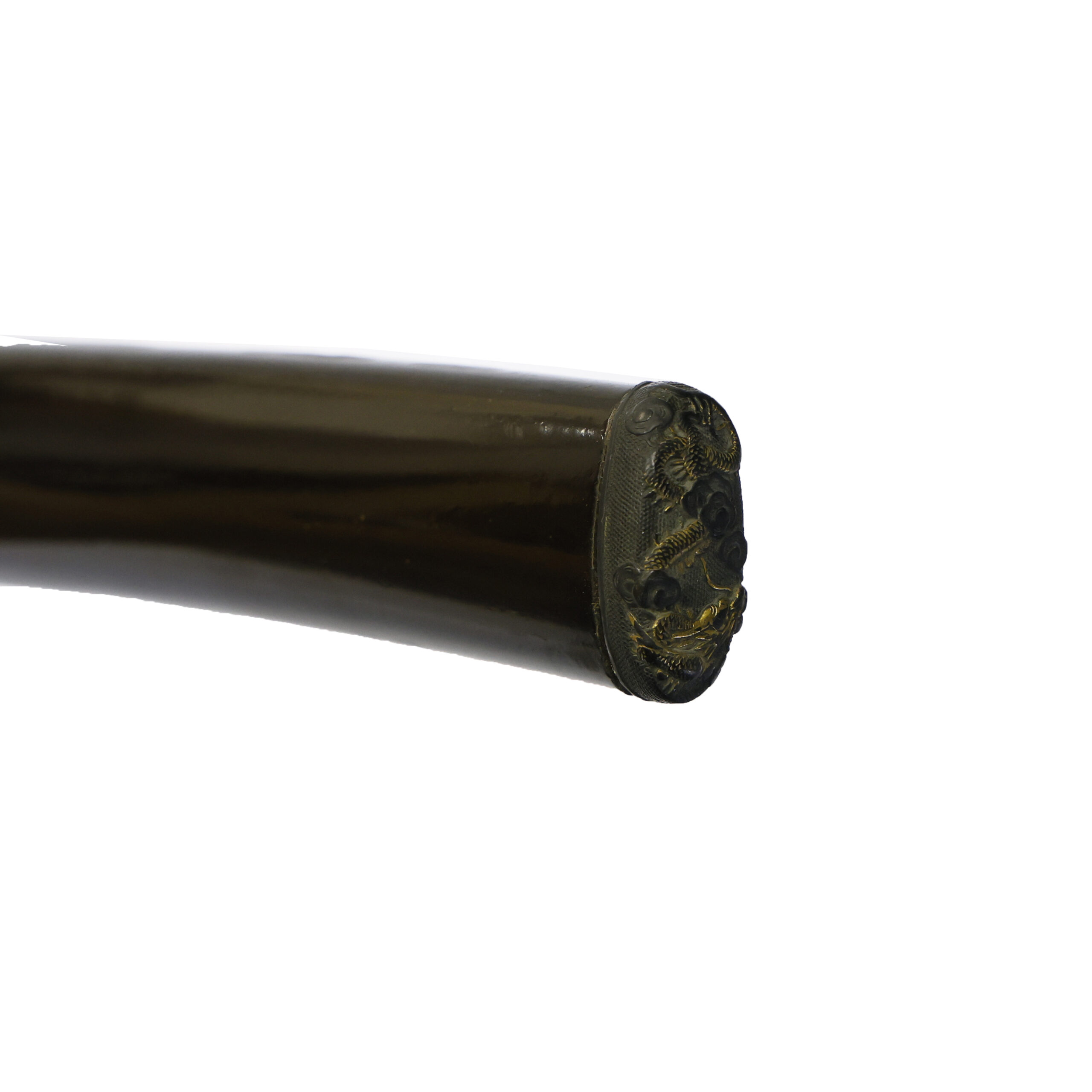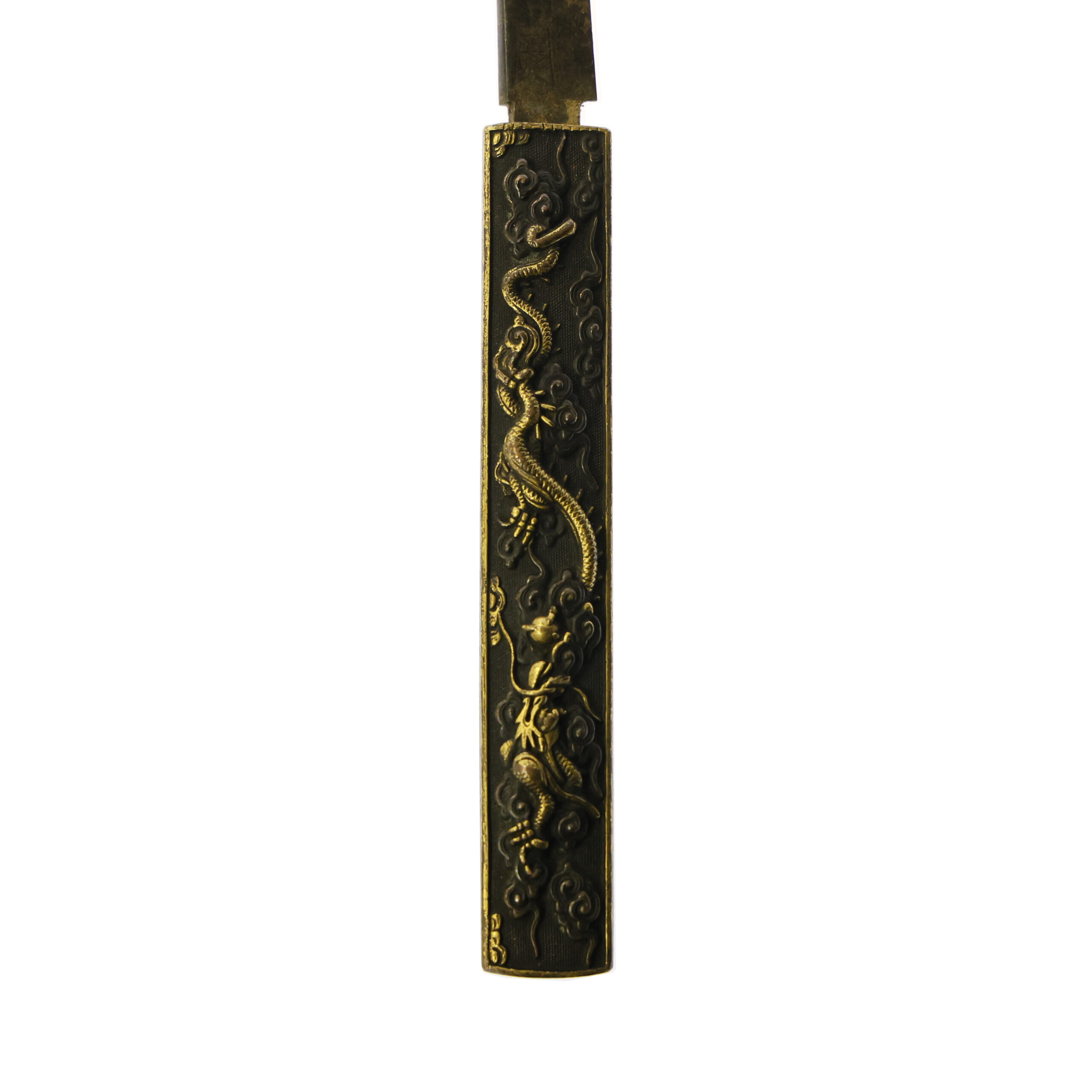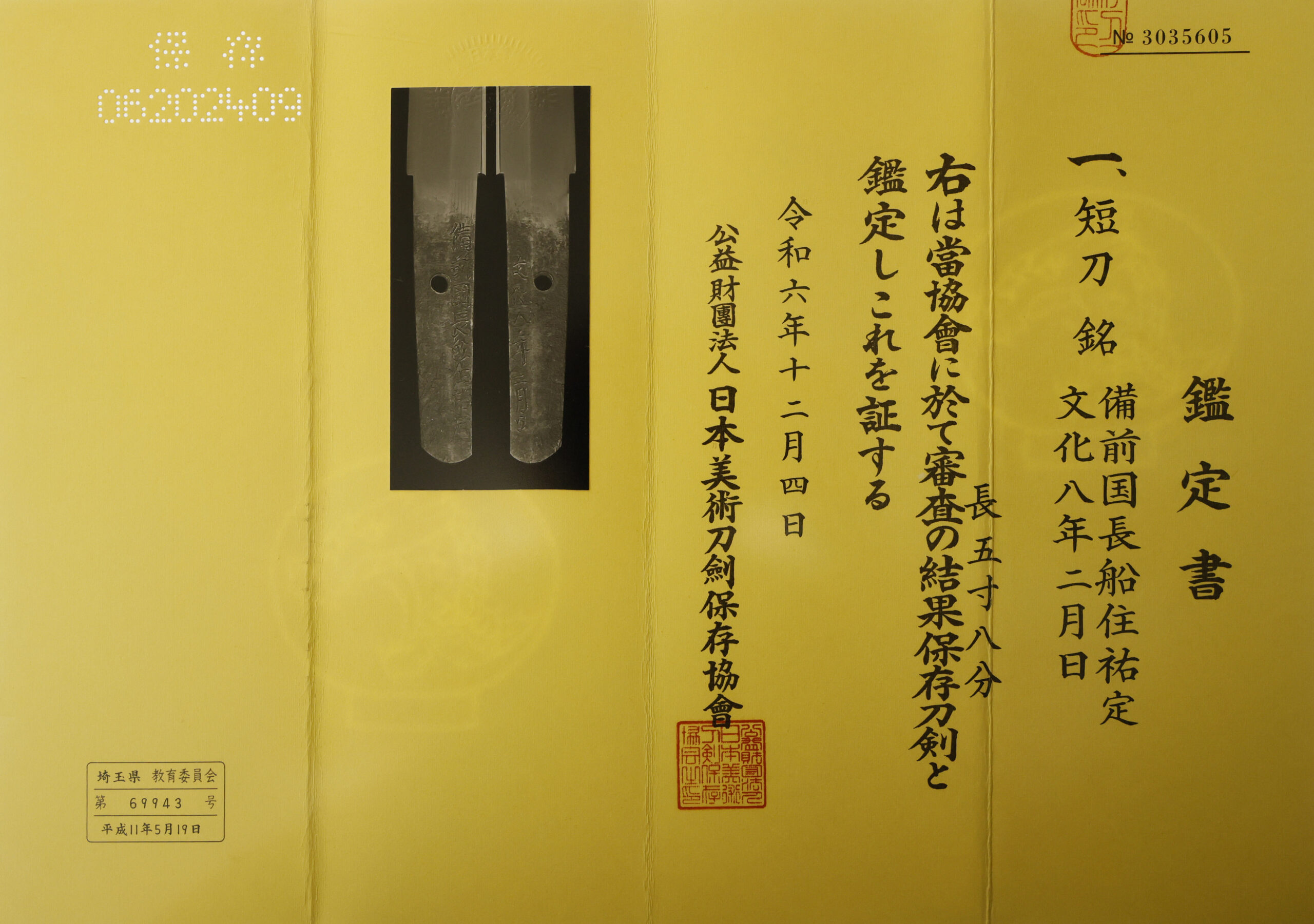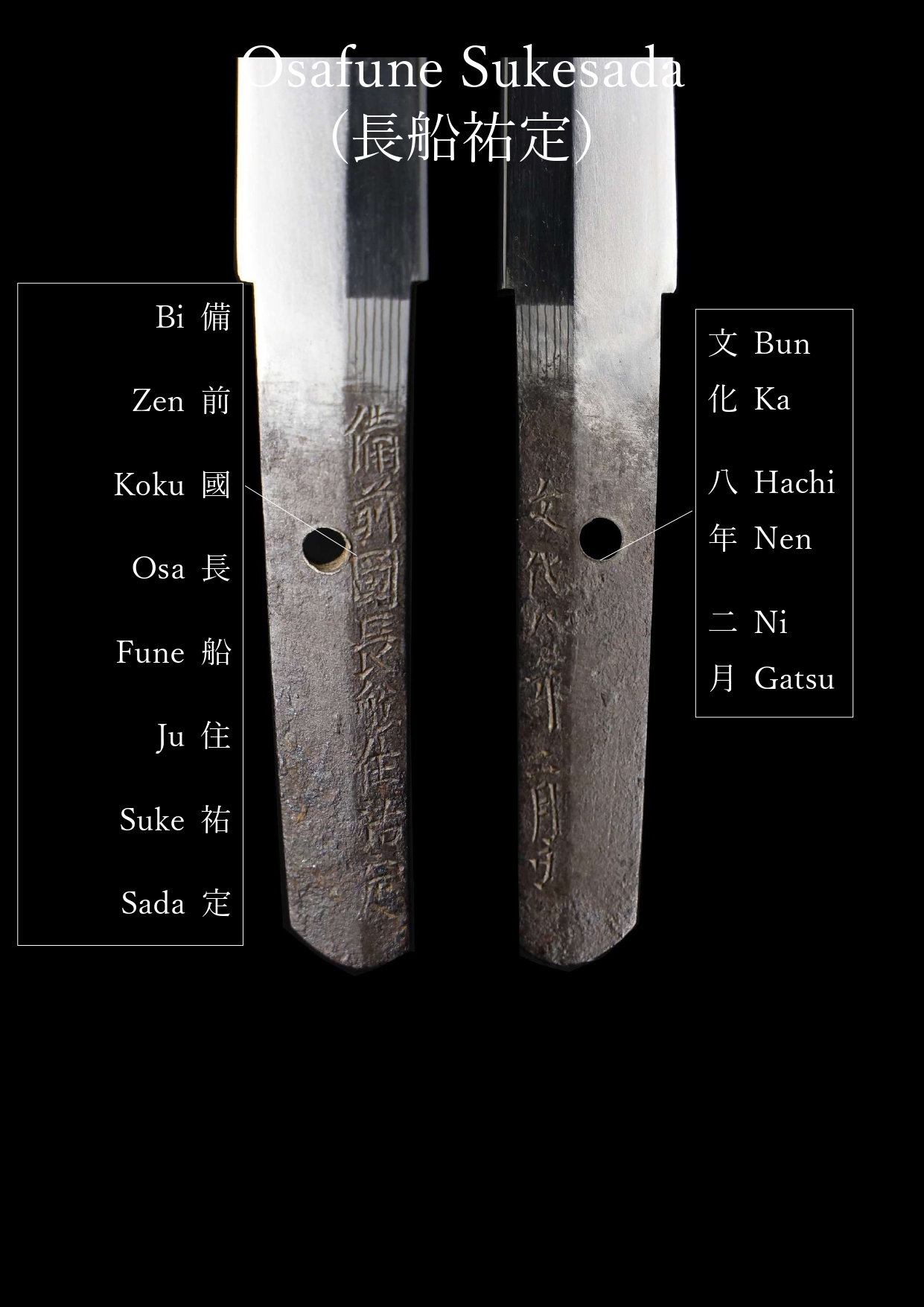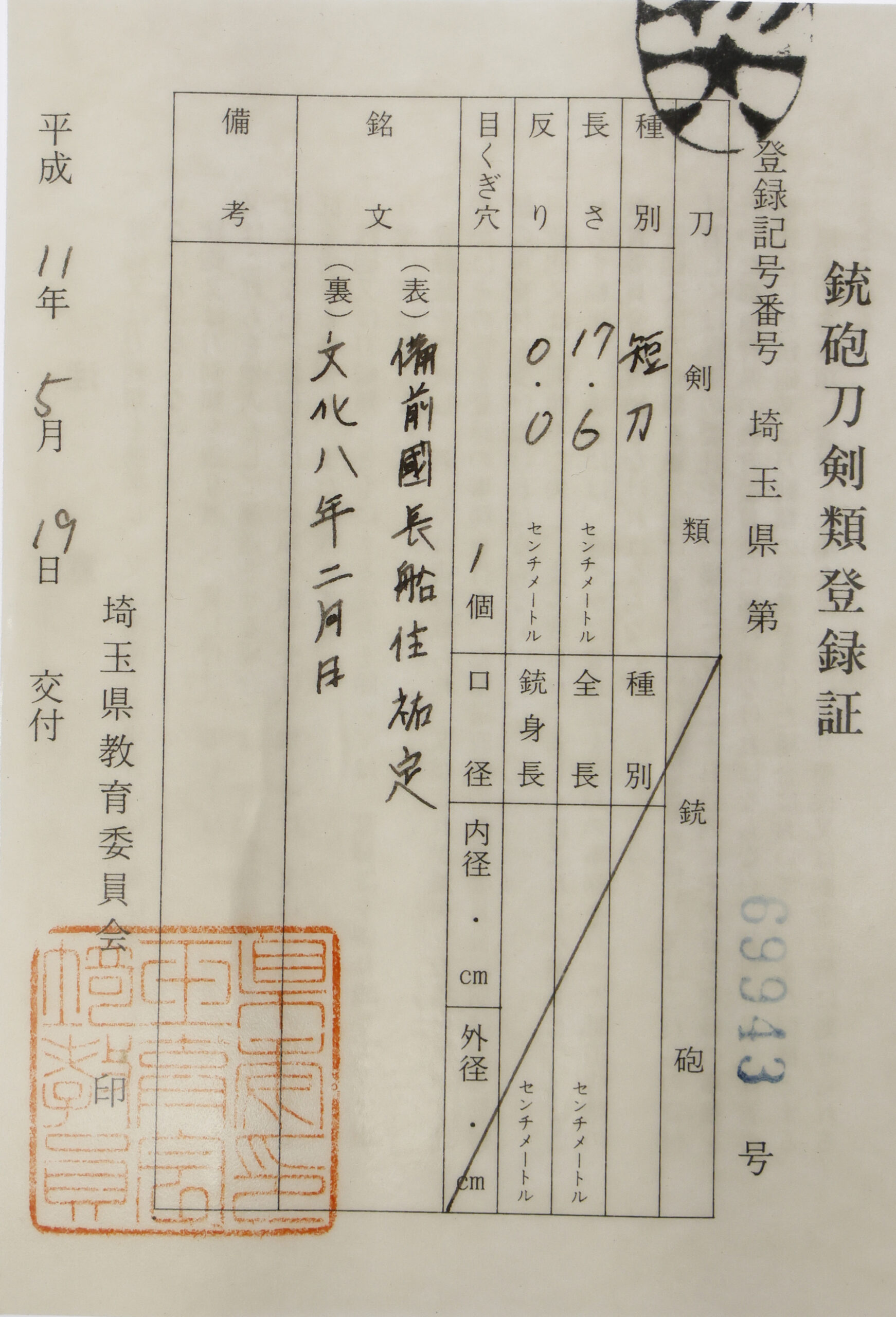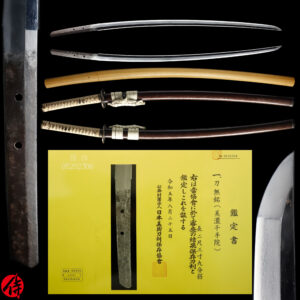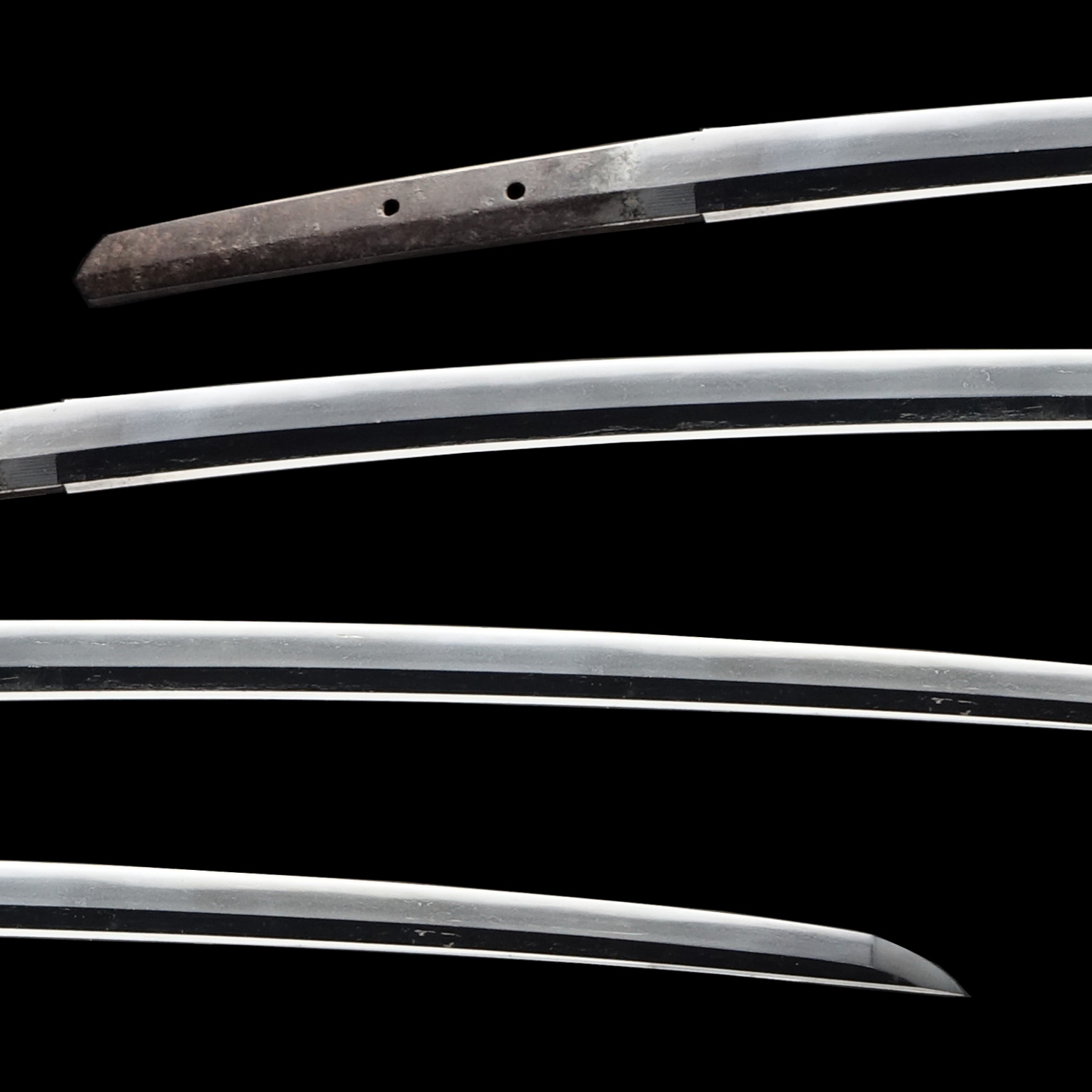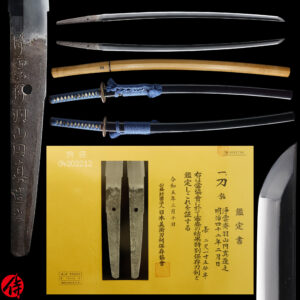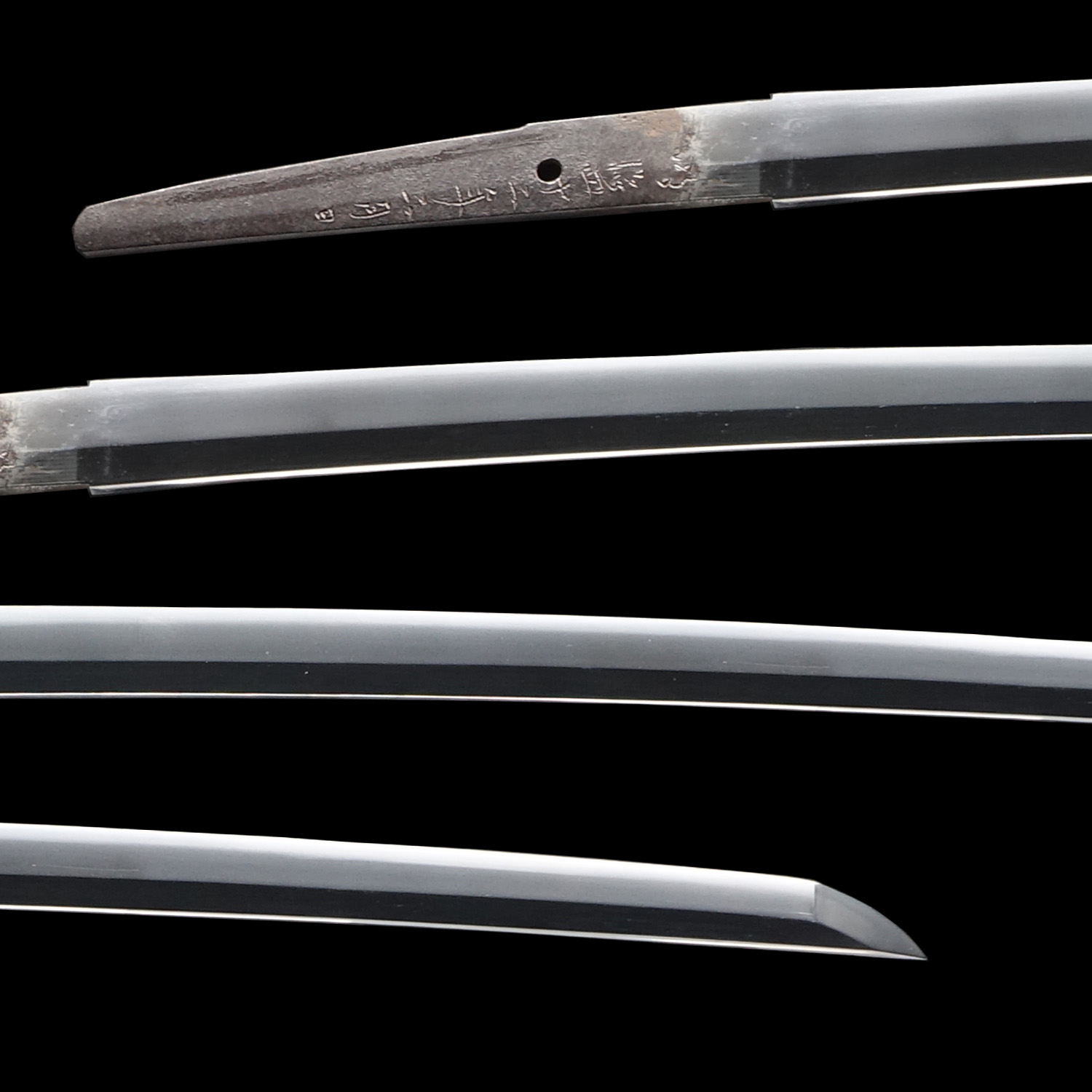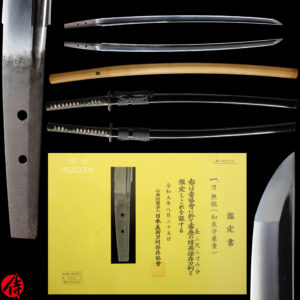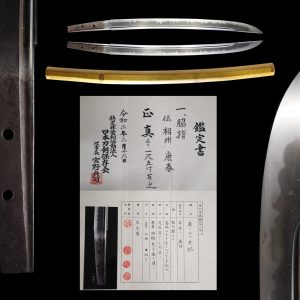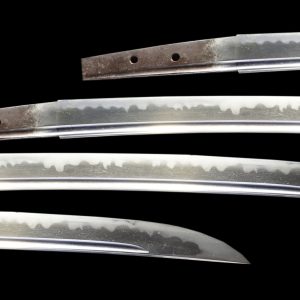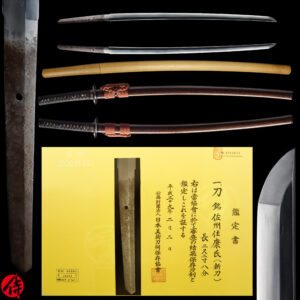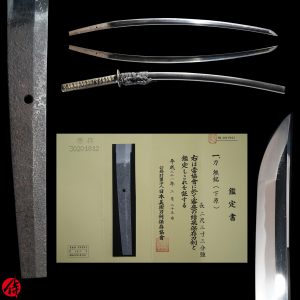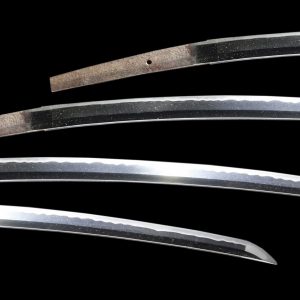Antique Japanese Sword Tanto Signed by Sukesada with NBTHK Hozon Certificate
【Description】
Summary
This sword bears the inscription “Bizen Koku Osafune Ju Sukesada” (備前国長船住祐定) and was forged in 1811 (Bunka 8) in Bizen Province, corresponding to today’s Okayama Prefecture. Sukesada was a member of the esteemed Bizen Osafune School, one of the most renowned sword-making traditions in Japanese history.
During the Muromachi period, Bizen swordsmiths produced a large number of blades due to the constant warfare of the Sengoku (Warring States) period. However, in 1591 (Tenshō 19), a catastrophic flood of the Yoshii River devastated the Osafune area, causing widespread destruction to swordsmith communities and facilities. As a result, Bizen’s sword-forging tradition temporarily declined.
Despite this setback, a few surviving swordsmiths preserved and continued the craft. Among them, the Sukesada lineage played a central role in its revival. One especially important figure was Yokoyama Tōshirō Sukesada, the fourth head of the Sukesada school. His descendants included Shichibei-no-jō Sukesada, grandfather of Yosōzaemon-no-jō Sukesada. Through their efforts, the tradition of Bizen swordsmithing experienced a remarkable revival during the Edo period.
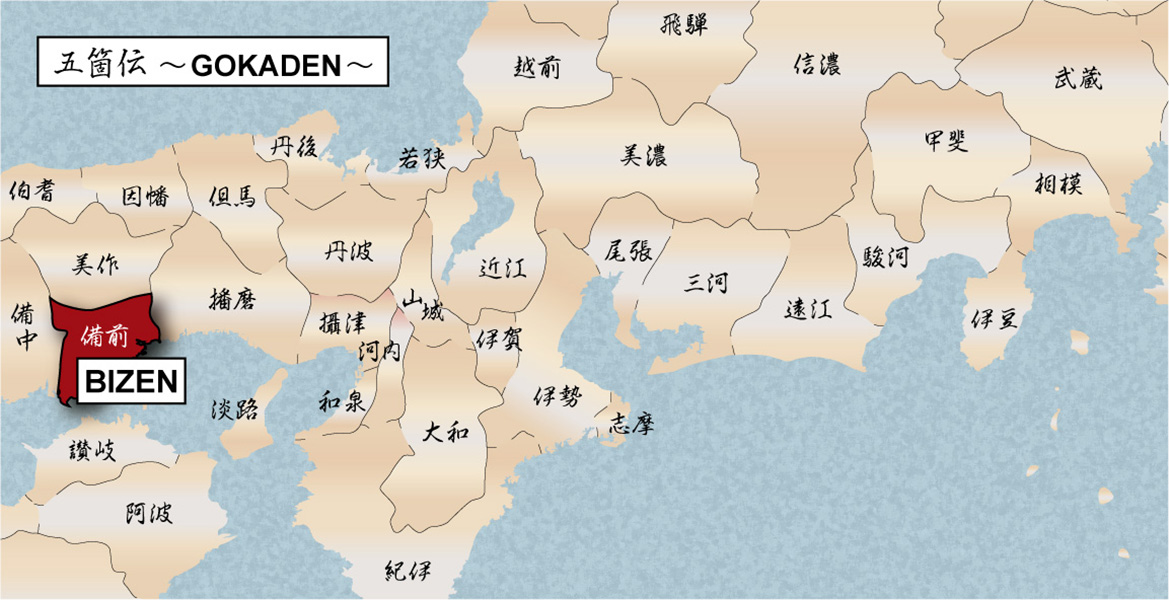
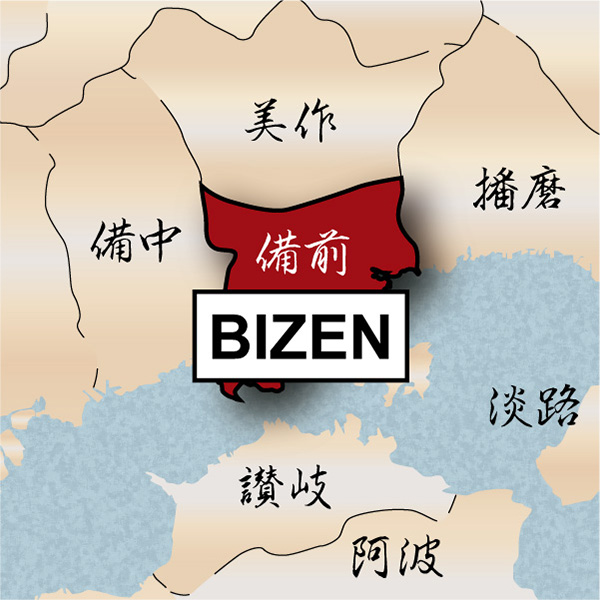
The History of the Bizen Osafune School
The Osafune School is said to have been founded by the swordsmith Mitsutada (光忠), who was active during the mid-Kamakura period. It became the largest and most prominent school in Bizen Province, regularly receiving commissions from powerful daimyō and celebrated samurai. Blades produced by the school were known as “Osafunemono” and were widely favored by warriors.
Among its many craftsmen, three masters stand out and are referred to as the “Osafune Sansaku” (Three Great Masters of Osafune): Nagamitsu, Sanenaga, and Kagemitsu. Additionally, four other smiths—Nagamitsu, Kanemitsu, Nagayoshi, and Motoshige—are known as the “Osafune Shitennō” (Four Heavenly Kings of Osafune).
The Bizen region was geographically ideal for sword-making. Located at the foot of the Chūgoku Mountains, it had abundant iron sand, a key material for forging blades. The nearby Yoshii River also provided ample water and charcoal, making the area particularly well-suited for high-quality sword production.
Swordsmithing in Bizen dates back to the late Heian period (late 12th century), when early groups of craftsmen laid the foundations of what became known as the Bizen-den tradition. These early smiths are now called Ko-Bizen (Old Bizen) swordsmiths. Their techniques were passed down through generations and were instrumental in the flourishing of the Osafune School from the mid-Kamakura period onward.
What is Tanto?
Japanese swords under the blade length of 30cm (11.6 inches) are generally called TANTO, and sometimes TSUBA(鍔; Hand-Guard) is not attached to the TANTO. It was easy to carry and convenient for close combats. It was initially used as a supplemental weapon for Samurai on horseback, who used a pole weapon or long sword in the Kamaura-Muromachi period. Samurai aimed at an unprotected area of his enemy’s armor with Tanto while having to fight with close distance.
TANTO was named accordingly, depending on how you carry it, such as HUTOKORO-GATANA (懐刀; Stomach-Sword) or KOSHI-GATANA(腰刀; Waist-Sword) or elsewise. TANTO was also a gift for a bride from her family in a traditional Japanese wedding, as it is believed that TANTO would be divine protection from evil power.
This blade is appraised as a Hozon Touken (保存刀剣) issued by NBTHK (Nihon Bijutsu Touken Hozon Kyokai: 日本美術刀剣保存協会). This authentication paper was only given to authentic Japanese swords, well preserved and high quality with artistic value.
【Blade】
Cutting Edge Length (Nagasa): 17.6 cm (6.9 inches)
Curvature (Sori): 0.0 cm (0.0 inches)

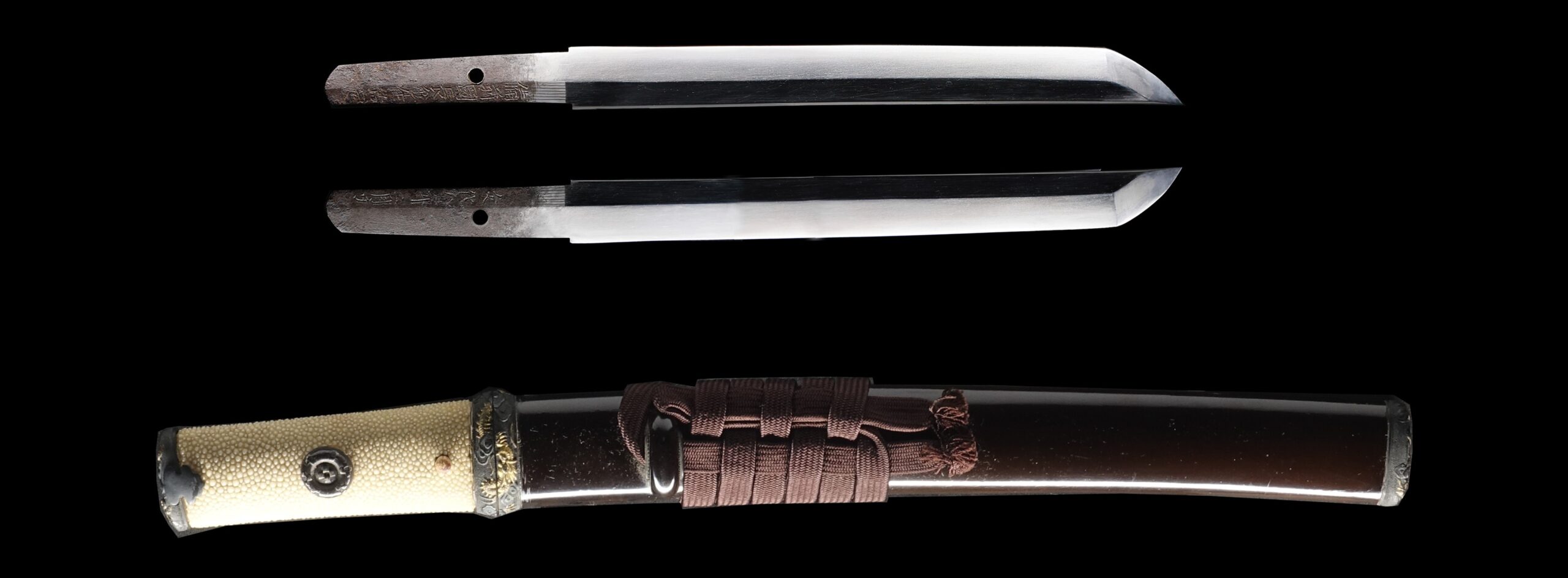
Hamon:
The crystalline structure which forms along the cutting edge of a blade as a result of the hardening process.
Jimon (Jihada):
Visible steel surface pattern created by folding and hammering during forging process.
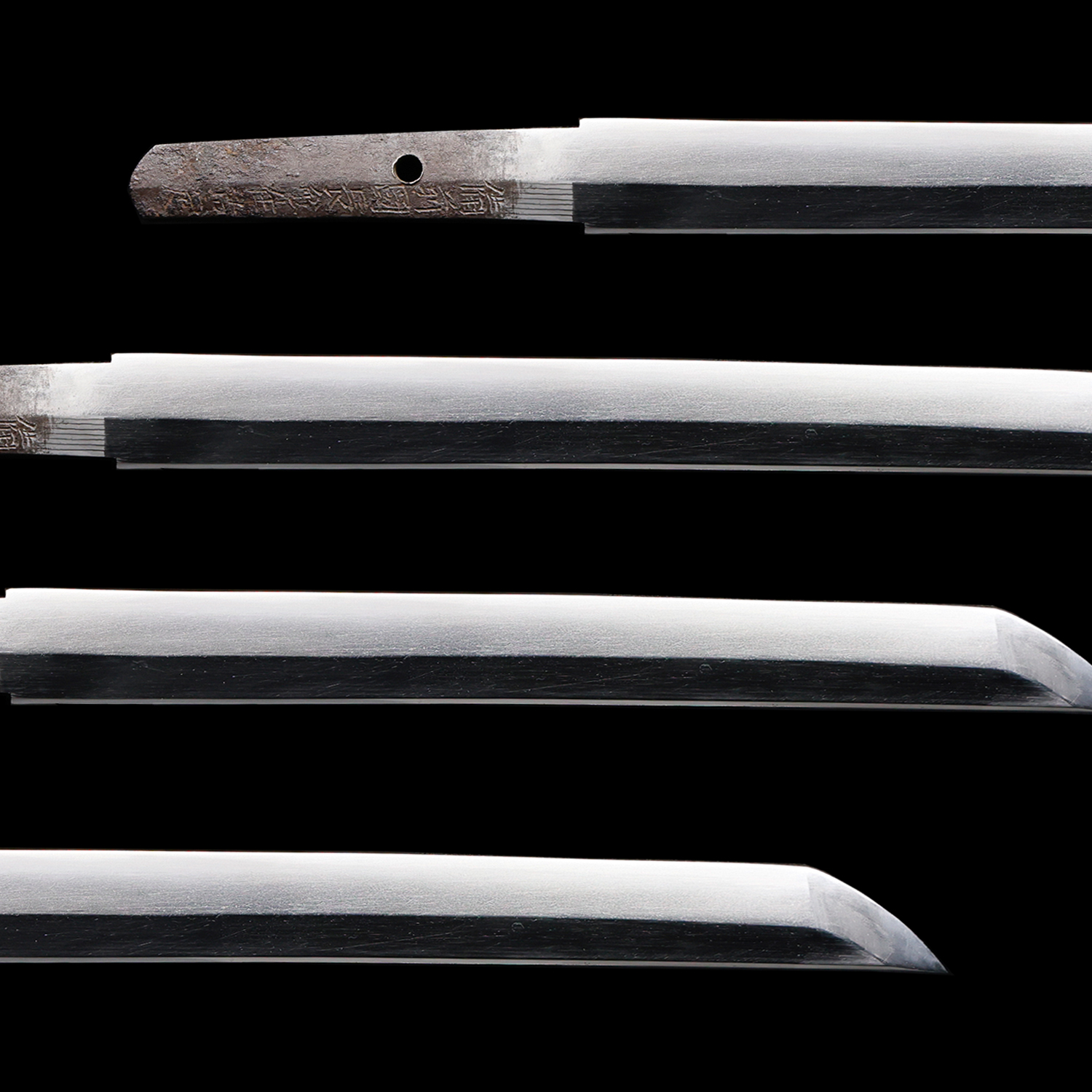
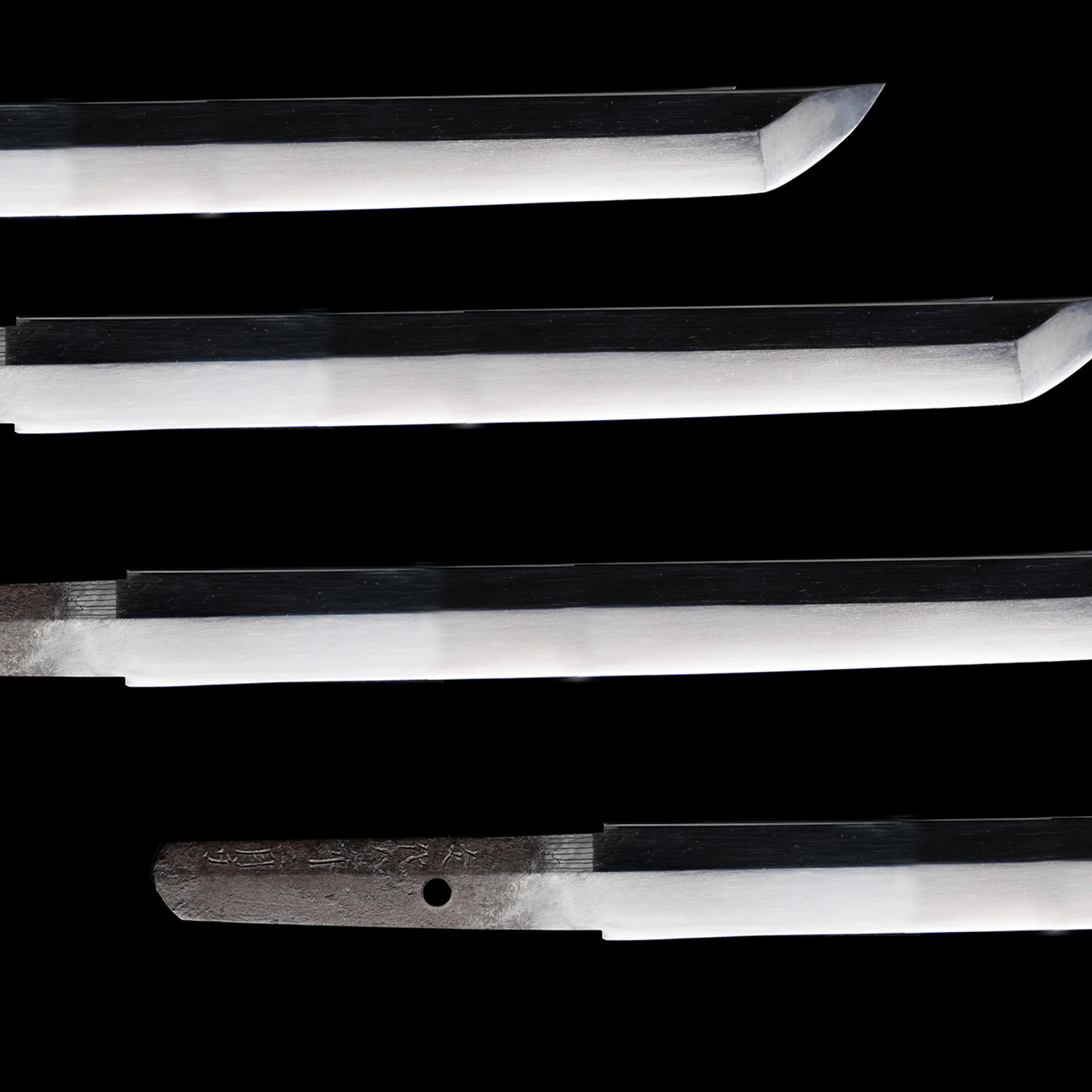
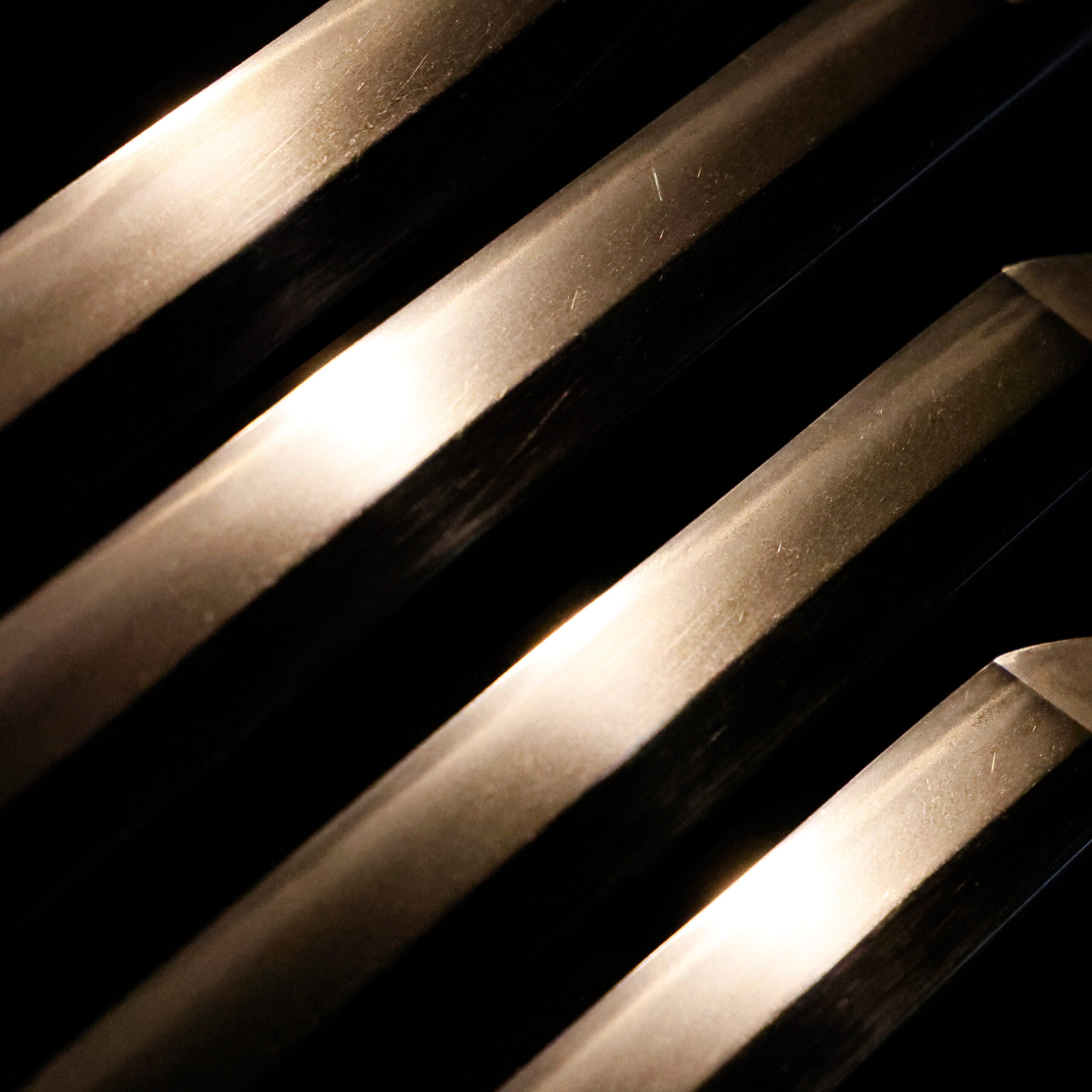
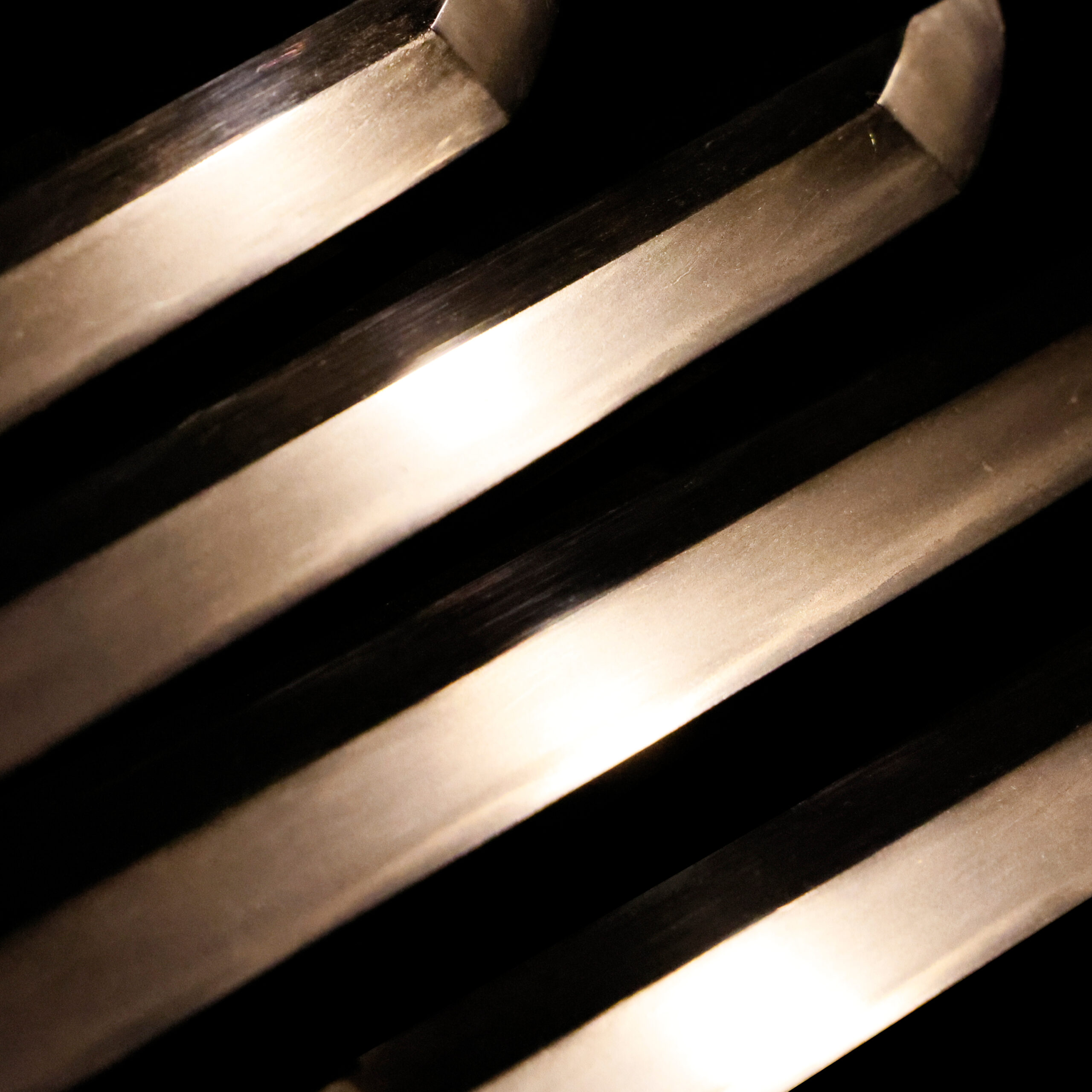
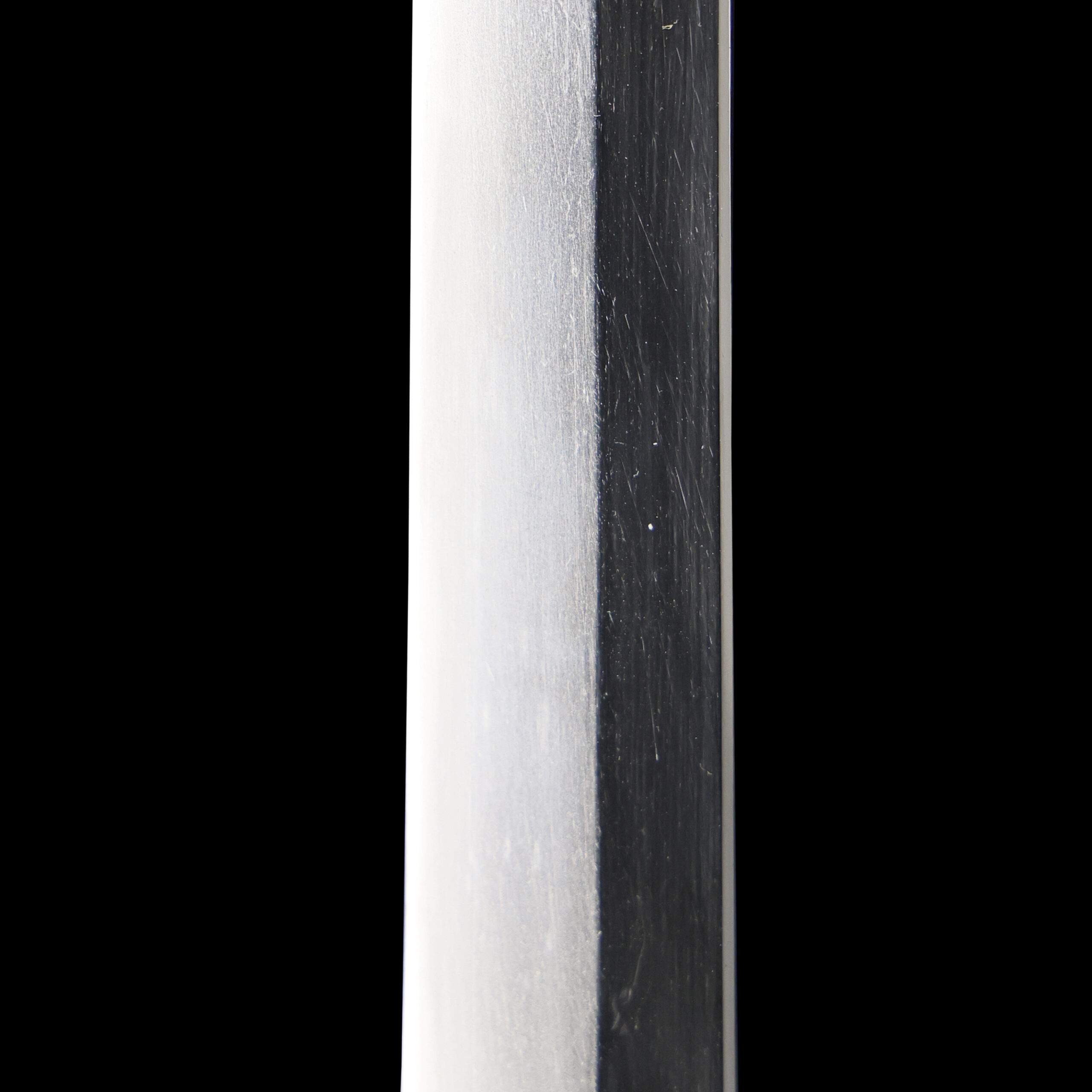
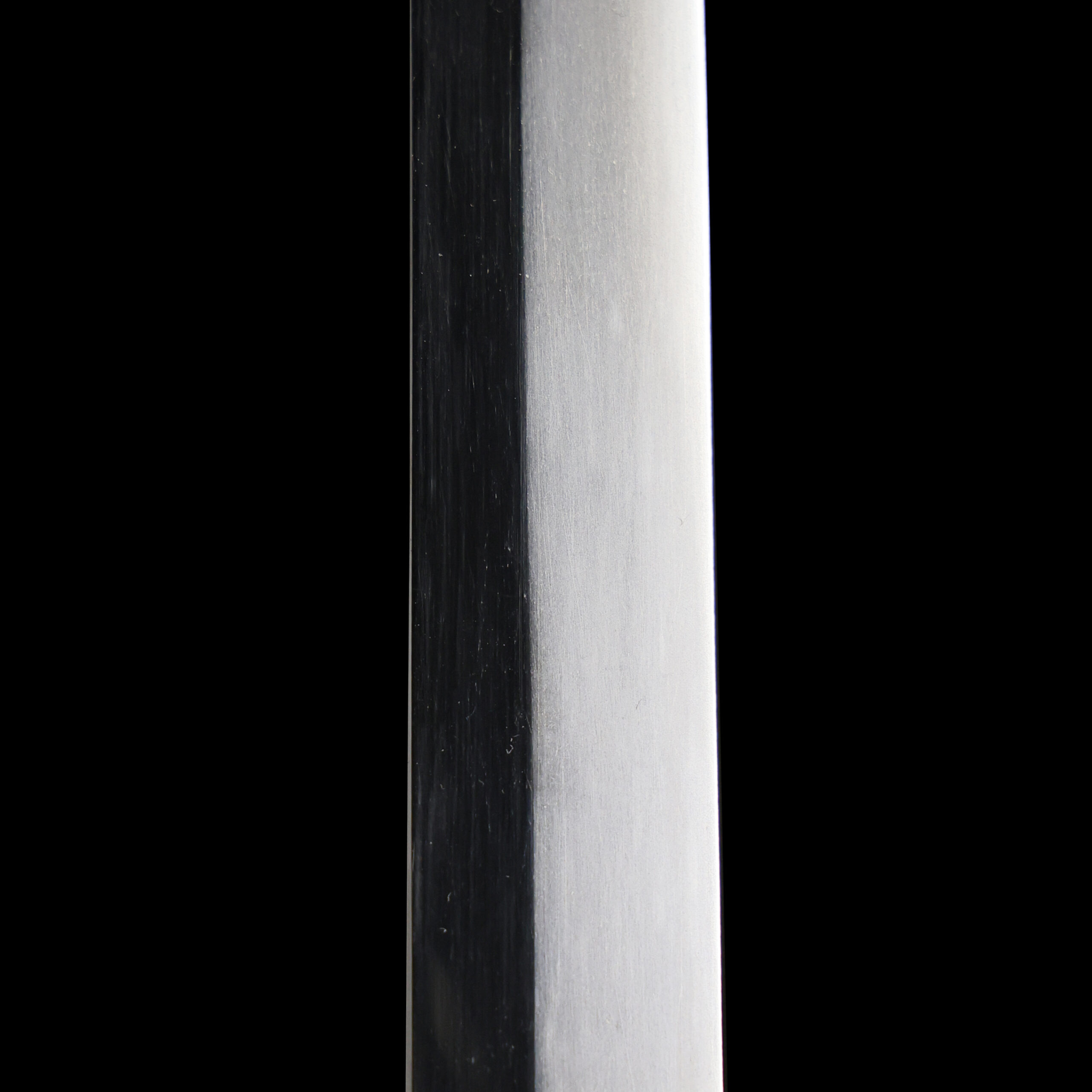
Kissaki: Kissaki is the tip of the Japanese sword.
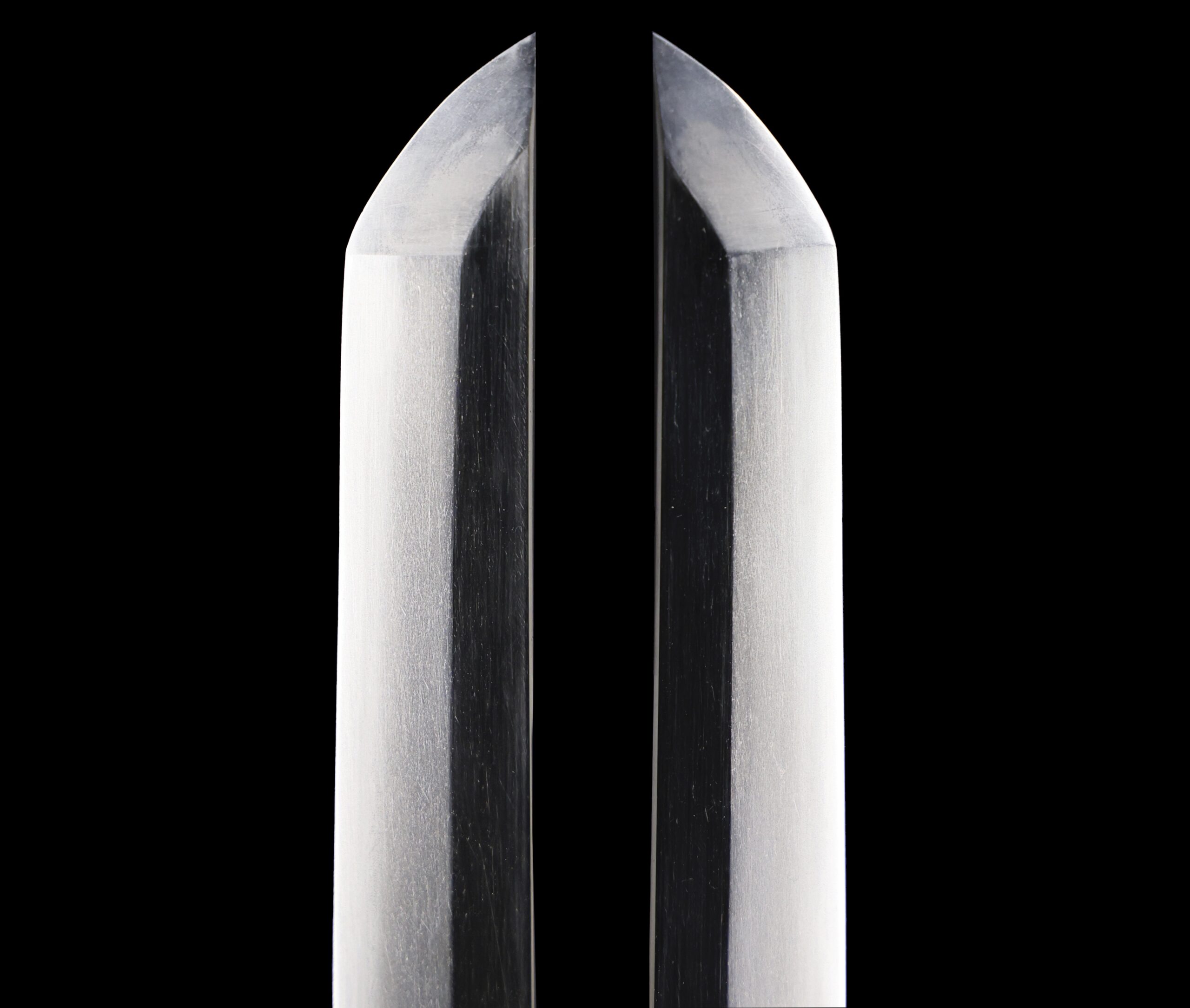
Nakago: Nakago is the tang of the Japanese sword.

Koshirae: Koshirae is the mounting of the Japanese sword. There are several parts that consist of Koshirae such as Saya (Scabbard), Tsuka (Handle), Tsuba (Handguard).
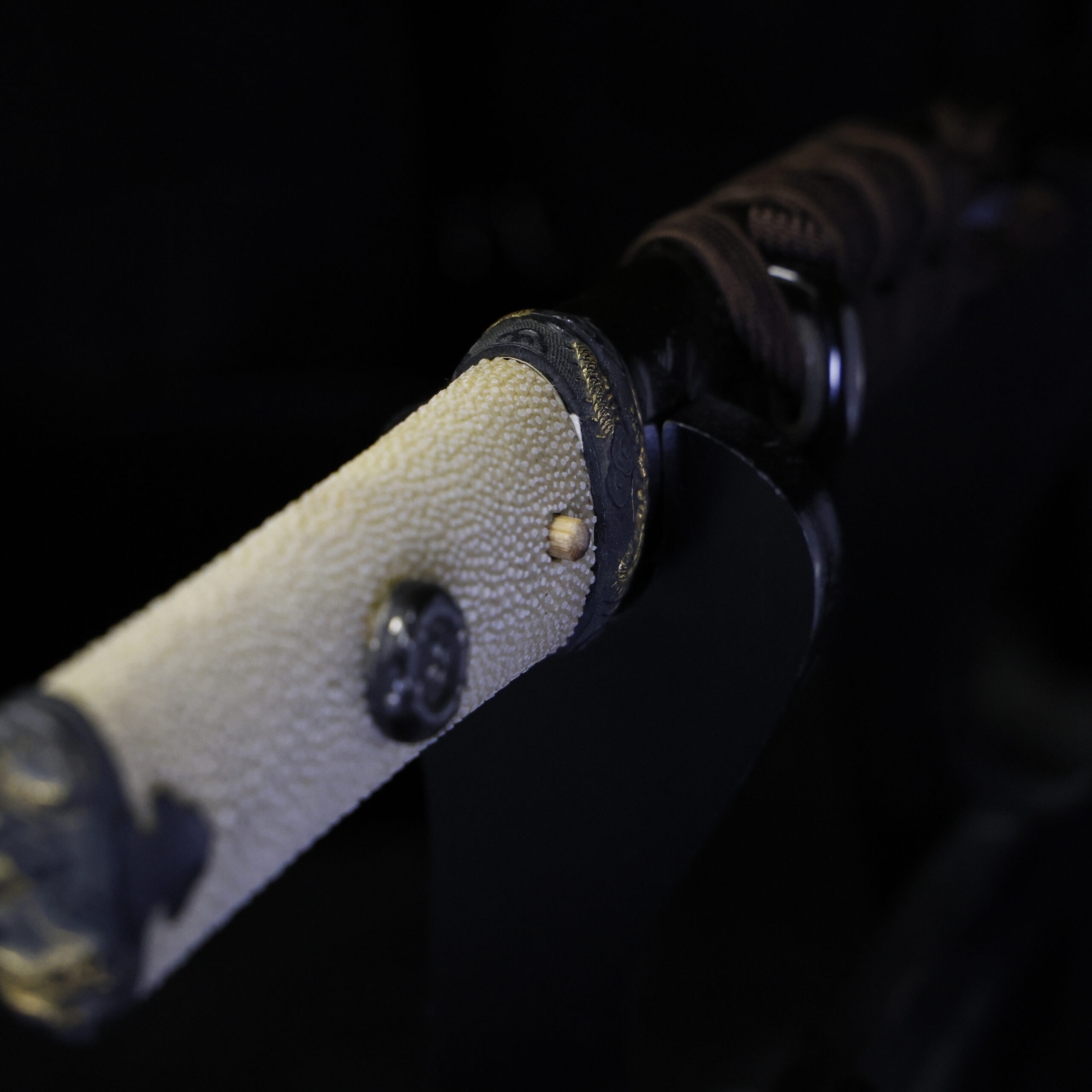
Fuchi-Kashira: A pair of matching sword fittings that cover the upper and bottom parts of its sword hilt.
The theme of this Fuchi-Kashira is Unryu Zu (雲龍図). It is a combination of dragons (龍) and clouds (雲). Initially, dragons were imaginary creatures found in ancient foreign traditions or myths. Furthermore, it is regarded as a symbolic beast of auspicious signs. Its body is likened to nine animals: antlers are deer, the head is a camel, eyes are demons, the neck is a snake, the belly is the Mizuchi (蛟, a mythical animal in Japan that looks like a snake and has a horn and four legs), scales are fish, claws are falcons, palms are tigers and ears are cows. It was thought that the dragon would reign at the top of all animals because of its odd-looking appearance.
Regarding the cloud pattern, clouds bring blessed rain and snow, and their movements significantly affect the day’s weather. Due to its supernatural power, a theory says that gods, spirits, and dragons dwell in the clouds. In Japan, there is a belief that worships dragons as water gods. Since rice cultivation has flourished in this country, people always treat water as an essential resource. We imagine some people wished for a plentiful harvest in the Unryu theme. From such a religious aspect, we could infer that dragon designs were familiar to people.

Tsuka and Menuki: Tsuka is the handle of the Japanese sword and Menuki is its decoration.
This menuki features a Japanese family crest (家紋, kamon) known as “Yotsu-ishi within a circle” (丸の内に四つ石紋, Maru no uchi ni Yotsu-ishi-mon). The design consists of four small stones (四つ石) arranged in a square pattern, enclosed by a bold circular line. This type of symmetrical crest was traditionally used to identify families and was often engraved on sword fittings and armor.
Another design related to this motif is the “Ishidatami-mon” (石畳紋), or stone-paving crest, which is based on a checkered pattern resembling a stone pavement. It is also known by other names such as “Arare-mon” (霰紋), meaning hailstone pattern, or “Seki-mon” (石紋), meaning stone pattern.
This type of geometric design has deep historical roots in Japan. It was a representative pattern used on the formal court trousers (表袴, ue no hakama) worn by aristocratic men during the Heian period (平安時代, 794–1185), and it remained in use through the Edo period (江戸時代, 1603–1868). The use of such patterns reflects both aesthetic refinement and social identity in traditional Japanese clothing and sword mountings.

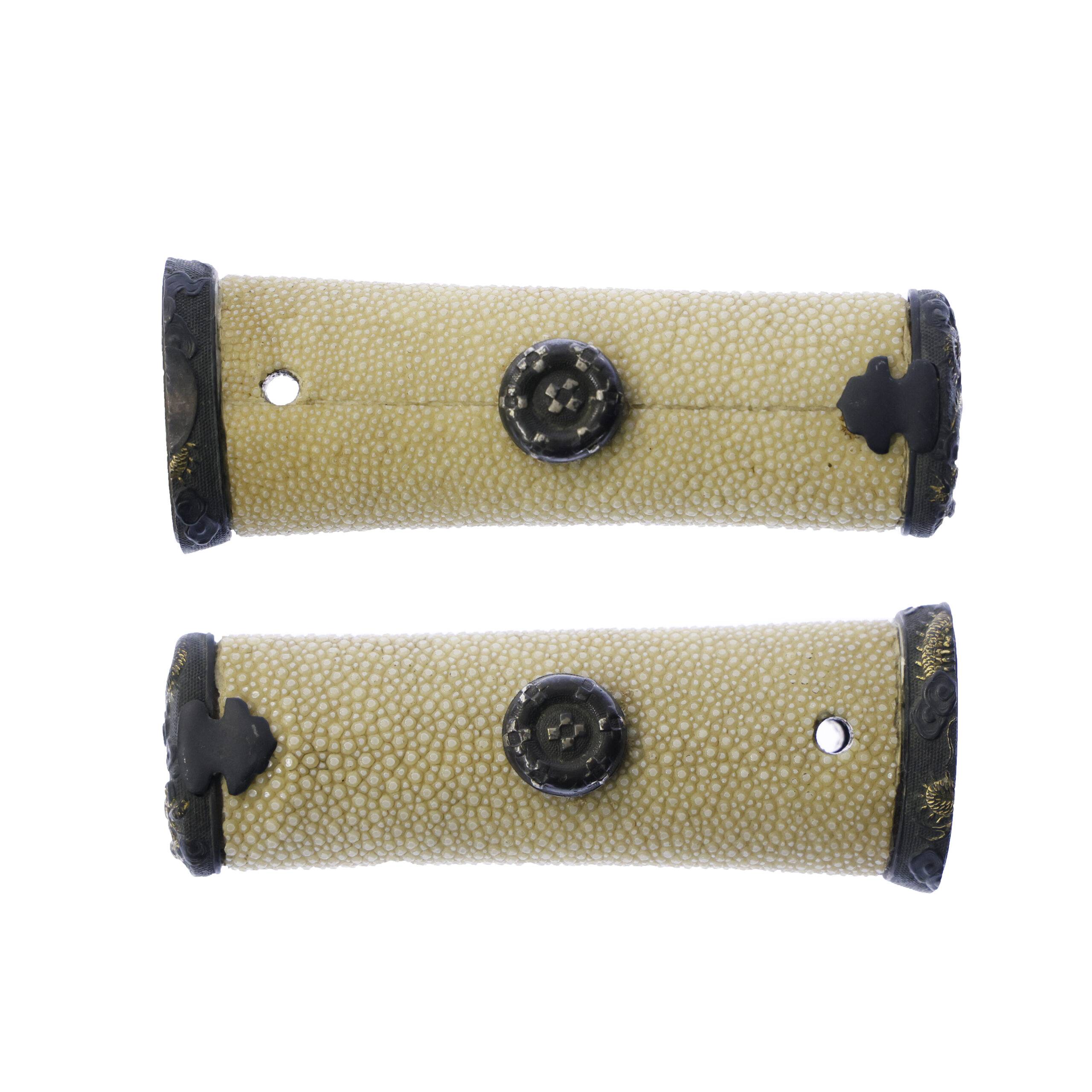
Kozuka: Kozuka is a small knife stored in Kozuka Hitsu(groove of the sheath of the Japanese sword).
The motif of this kozuka (小柄) is the same as that of the fuchi-kashira (縁頭): Unryū-zu (雲龍図), or “Cloud and Dragon” design. This consistency in theme creates a strong sense of visual unity across the sword mountings.
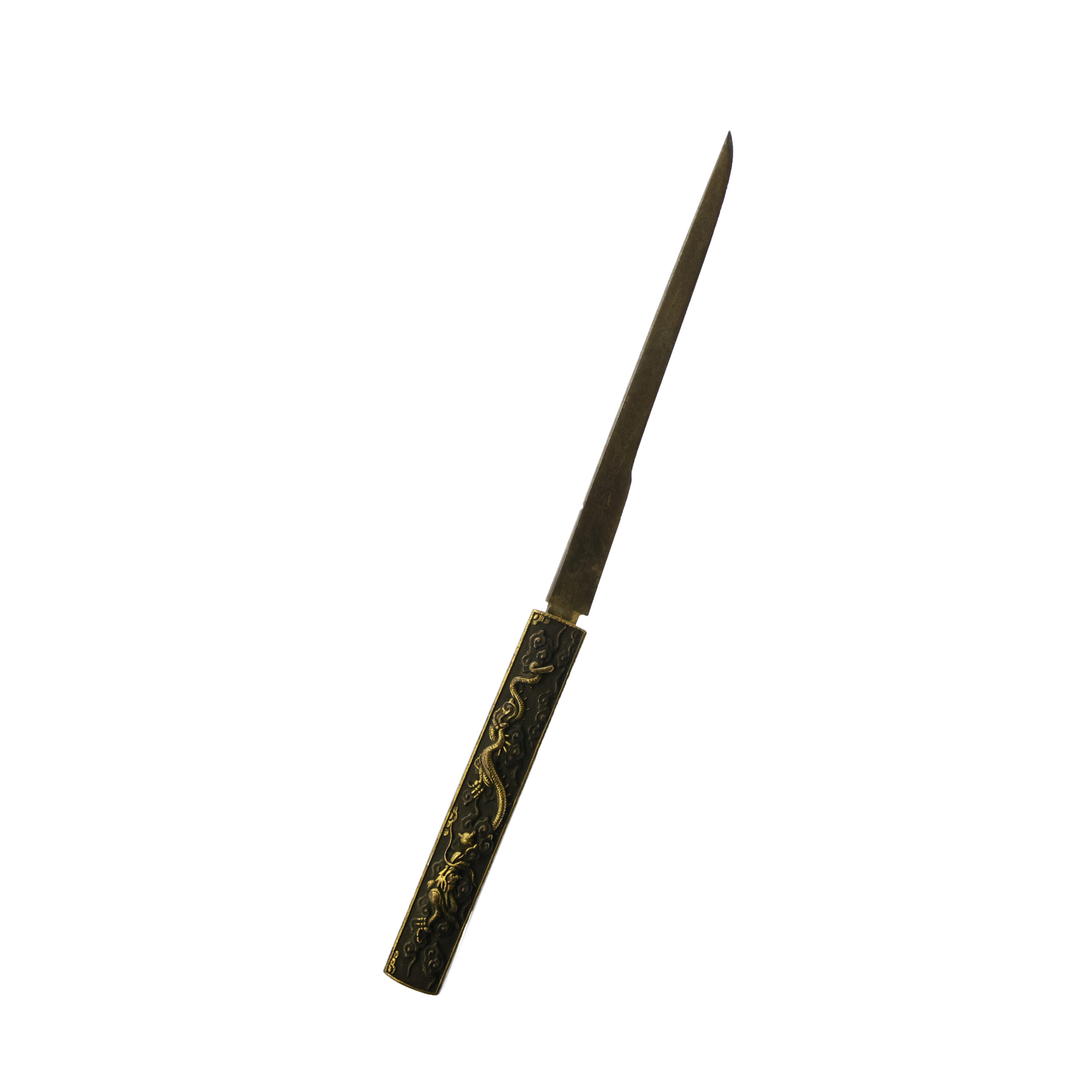
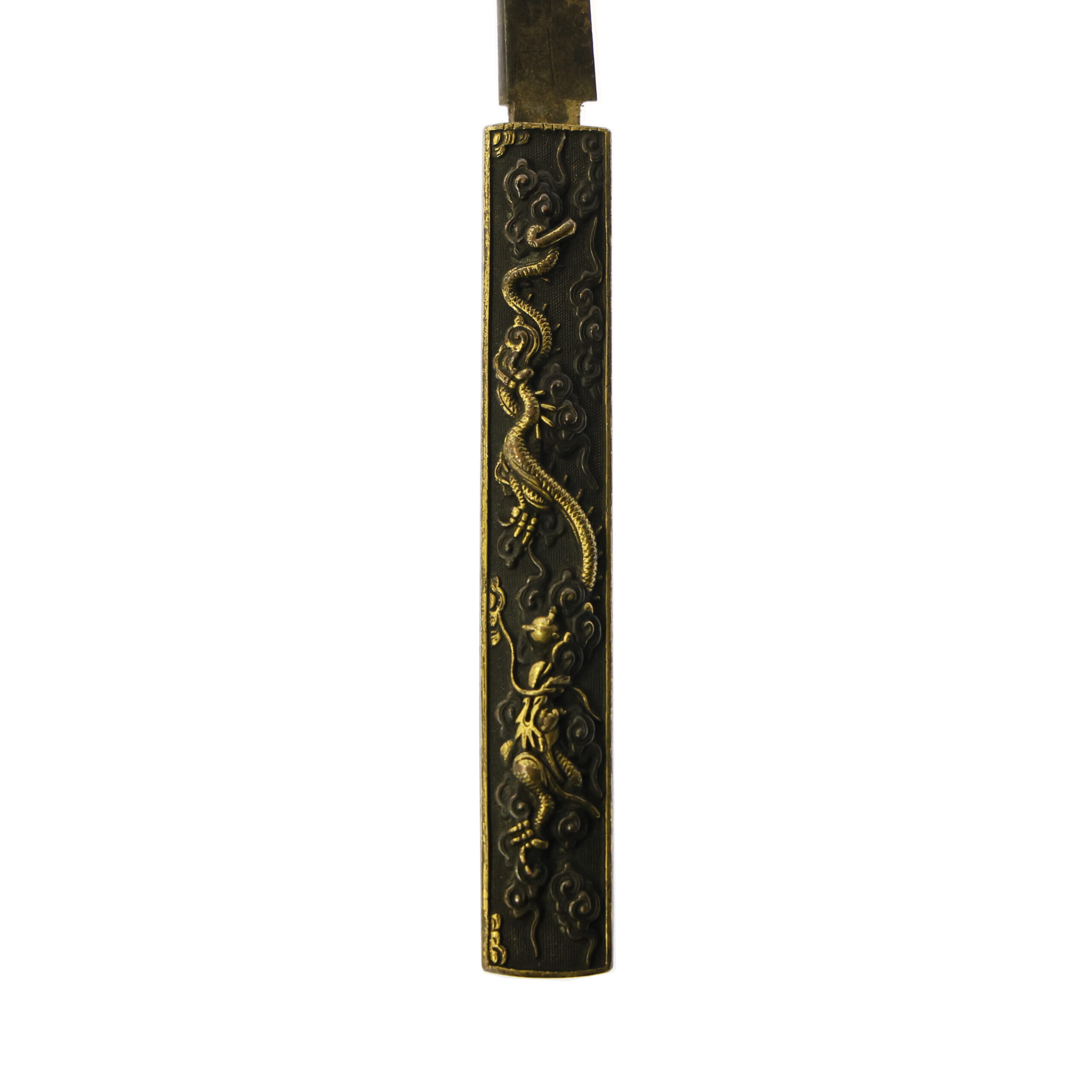
Saya: Saya is the scabbard for the Japanese sword
*Please keep in mind that there are a few scratches on the Saya. If you like to know the detailed condition, please feel free to contact us.
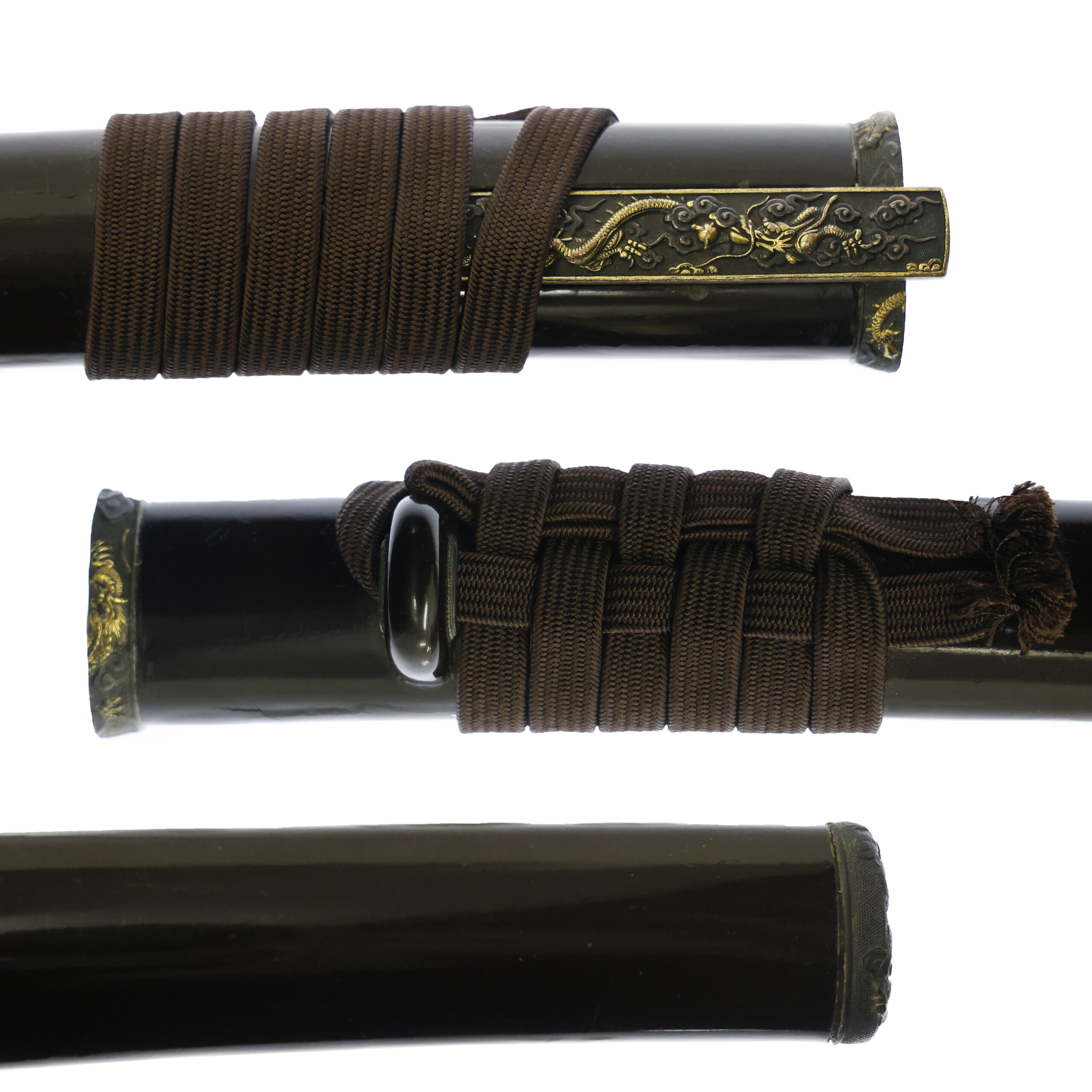
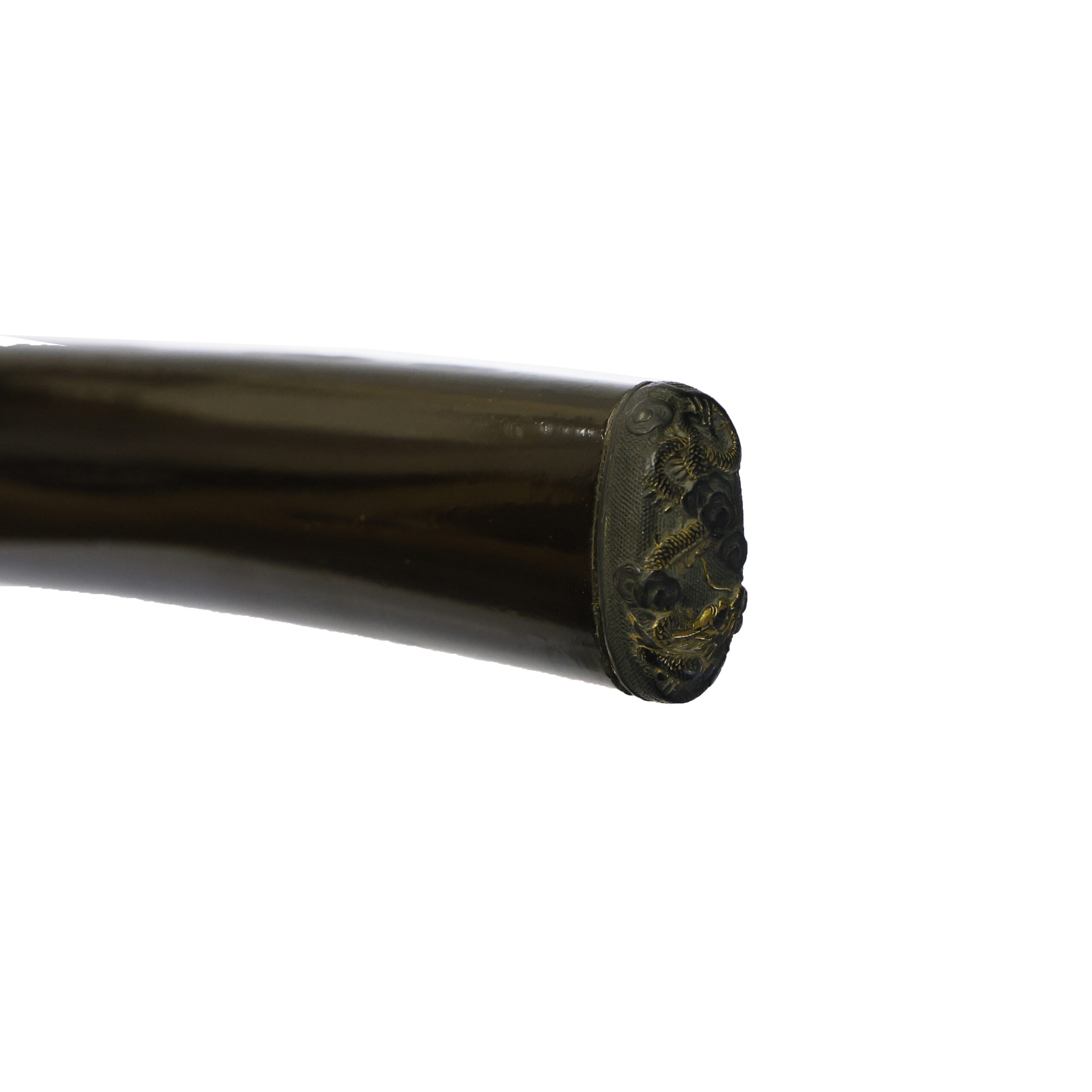
Authentication Paper: NBTHK Hozon Certificate for the blade (No.3035605)
NBTHK, also known as Nihon Bijutsu Touken Hozon Kyokai (the Society for the Preservation of the Japan Art Sword), is one of the oldest Japanese sword appraising organizations in modern-day Japan. They authenticated the blade on December 4th in the 6th year of Reiwa (2024). They appraised it as Hozon Touken, the blade worth preserving for Japanese society. The purchaser will receive this original certificate as well. We can also translate what is written into English and make a PDF file for your record if you request.
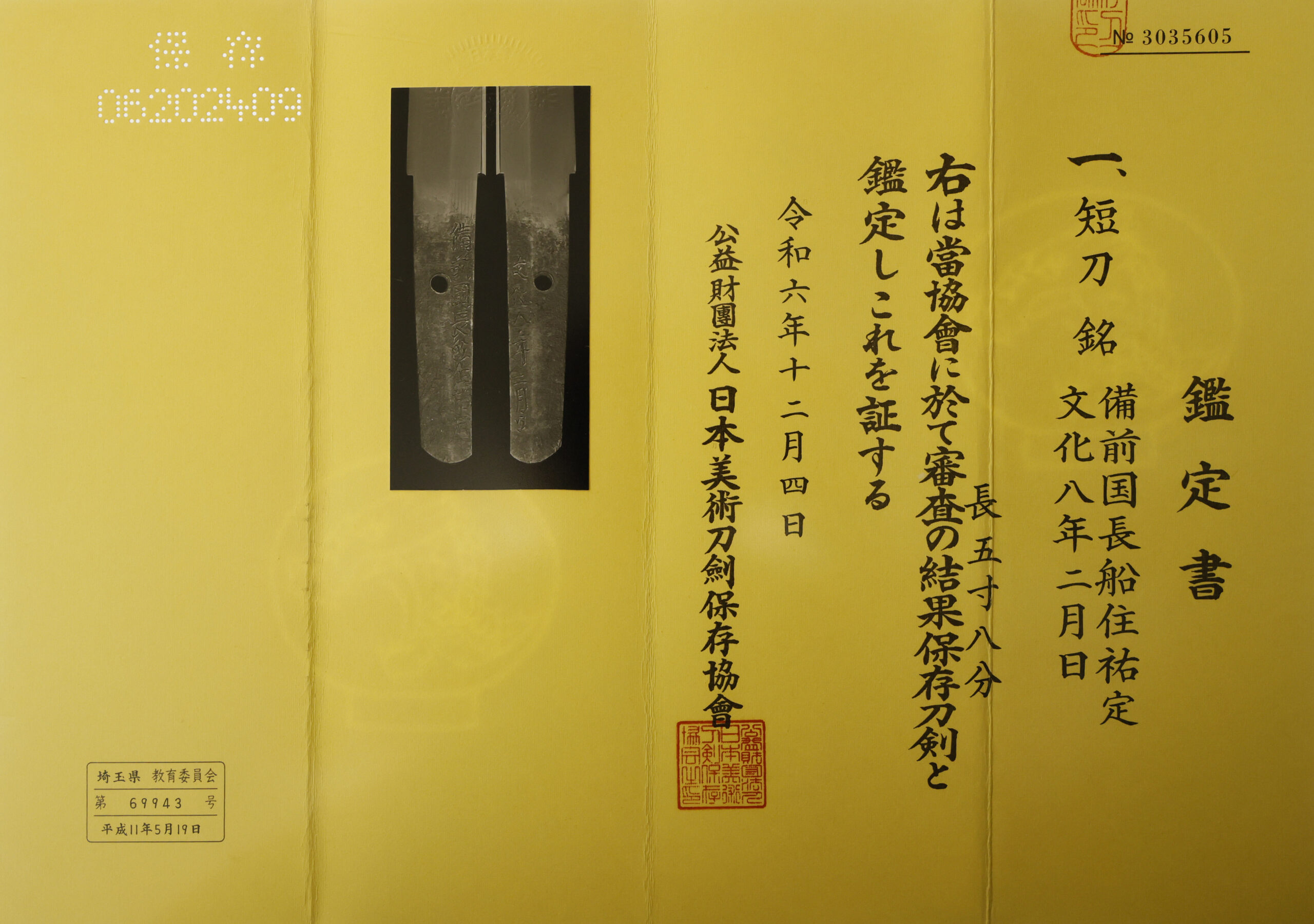
Registration Number: Saitama 69943
The Board of Education in Saitama prefecture issued a registration paper for this sword. It is called Jyu Hou Token Rui Torokusho (銃砲刀剣類登録証). Bunkacho (The Agency for Cultural Affairs) acknowledges a Japanese sword with this paper as a work of art.
The sword needs to be traditionally hand-forged and made of Tamahagane carbon steel to be registered in the system. With this paper, its owner in Japan can legally own an authentic Japanese sword. Based on this registration number, we will apply for its export permit.
This paper will need to be returned to the board of education when the sword is being shipped abroad, but you can receive a copy of it. An English translation of this registration paper is available on request.
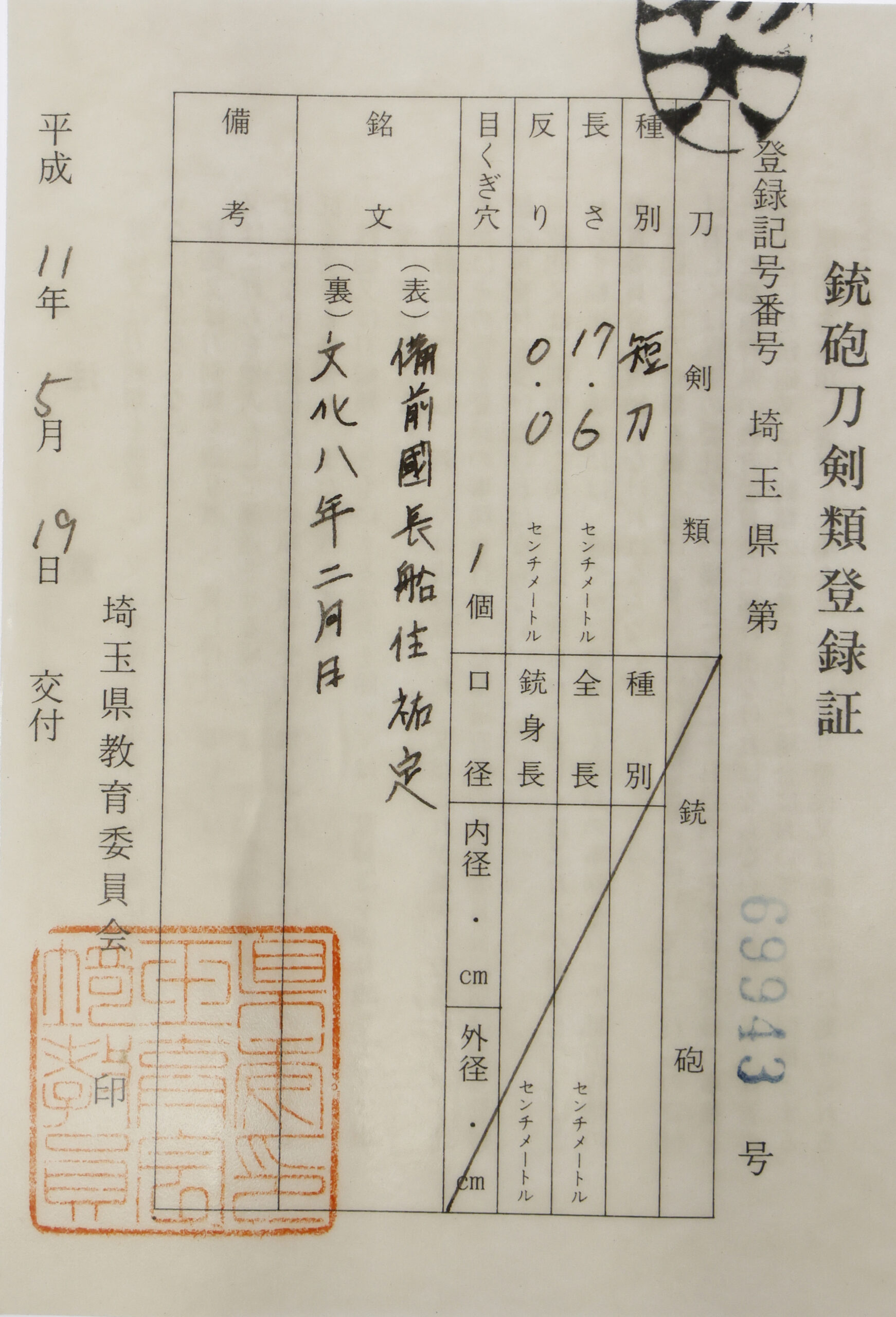

【About us】
Samurai Museum is located in Tokyo, Japan, exhibiting antique artifacts related to the Samurai history. Samurai Museum Shop is the place for those who are interested in Japanese culture and craftsmanship. We deal with antique Samurai swords/armor, traditional crafts made in Japan and so on.
【Japanese Sword& Export Process】
The Japanese swords we deal with are hand-forged edged swords made in Japan. It was made from the traditional carbon steel called TAMAHAGANE(玉鋼). Samurai Museum is familiar with the proper legal procedure for an antique/ authentic Japanese sword to be exported from Japan. We have sent more than 1000 Japanese swords for the past few years (~2025) to amazing owners who appreciate its historical value.
Each Japanese sword is registered under the Agency for Cultural Affairs and the Board of Education in Japan. They issue a registration paper for each Japanese sword for its owner in Japan to legally possess it. The Japanese sword with its registration paper means it was traditionally hand-forged in Japan.
To legally export the sword from Japan to other countries, we will have to apply for its permit to the Agency for Cultural Affairs(Bunkacho) and return the original registration paper to the Board of Education. It normally takes around 2-4 weeks to receive this permit after submitting required documents. And we would like you to expect at least 1-1.5 months for your order to arrive at your given address after you ordered. For more detailed info, please click here.
It is allowed for residents in Japan to own authentic Japanese swords without a special license as long as they come with registration papers. Please feel free to contact us if you are a resident of Japan, whether temporarily or permanently. We will also assist you when you leave Japan and need to obtain the export permit.
【Payment Method】
We accept payment through Stripe (Credit card), PayPal, Apple Pay or ChromePay, all of which are secure payment methods. Also, you don’t need to make an account on Stripe for the checkout. If you prefer other payment method, please contact us. After confirming your payment, we will apply for an export permit. You may either pay in JPY, USD, AUD, CAD,EUR CHF or GBP. The price is set in Japanese Yen. Prices in other currencies are automatically calculated based on the latest exchange rate.

* If the amount is above 1 million JPY, Stripe or wire transfer will be the only options for payment.
【Shipping】
We have shipped authentic Japanese swords to the USA, Canada, Mexico, Germany , Belgium, France, Finland, UK, Hong Kong, Australia. If you don’t live in these countries and like to order, please contact us first before making a purchase. We offer Free International Shipping as long as we can send antique Japanese swords by EMS.
We normally ship by EMS(Express Mail Service) provided by Japan Post. We will send you a tracking number for your order as soon as we hand it to the post office. We will put 100 % insurance on the shipping document without any extra charge. Based on the total amount, there might be a duty tax or other fee for you to pay, depending on the countries. We use package cushioning to protect the item and put it in a PVC pipe, which is one of the most secure packages because of its durability.
It will normally takes 5-14 days for the item to arrive at your given address after we dispatch it. Time of delivery is estimated as accurately as possible by the carrier but does not take into account any delays beyond our control such as by inclement weather, post office holiday seasons.
* If you live in Australia and like to purchase an authentic Japanese sword, please click here to know the detail.
* If you live in the UK and like to purchase an authentic Japanese sword, please contact us first and click here to know the detail.

【Review】
Here is one of the reviews we received from a customer who purchased an authentic Japanese sword from us. For more reviews, please click here.
“My experience overall with the whole process was wonderful. I had many questions about the history and process to purchase these treasures. All my questions were answered very timely and complete. The staff is very knowledgeable and very well versed if any questions do arise.”
【How to make sure the condition】
Please keep in mind that what you are going to purchase is an antique item. We uploaded high resolution photos for you to check its condition thoroughly. If you like to see more photos with different angles, please feel free to contact us. We will be happy to send them to you so that you can make informed decision. It is essential for us to know that you are happy with your choice of a sword. and we are prepared to use the best of our ability to serve you.
【How To Contact Us】
Please contact us through email, Facebook Messenger or Live Chat if you have any questions. You can find each icon on the right side of the website. Please click one of them to reach us. We will reply to you within 1-2 business days.
【The Art of Nihonto (Japanese Sword)】
Samurai’s history is a profound, eloquent legacy of ancient Japanese warriors in which millions of people worldwide are being fascinated. If you like to find out the art of Nihonto, please click here.
【A Guide to Japanese Sword Maintenance】
After acquiring an genuine Japanese sword, it is also important to know how to take good care of it. Here is the special video for you. Mr. Paul Martin, Japanese sword expert, shows you how to give proper maintenance to your sword. By mastering how to clean the Japanese sword, its aesthetic beauty will last forever.
When you purchase a Japanese sword from us, you can get a Free Japanese sword maintenance kit. It comes with four tools(Choji Oil, Uchiko Whetstone Powder, Peg remover, Oil Applicator). By watching the video instruction above , you can enjoy learning how to maintain your Japanese sword while appreciating it. If you have any difficulty assembling the sword or cleaning the blade, you can feel free to contact us.
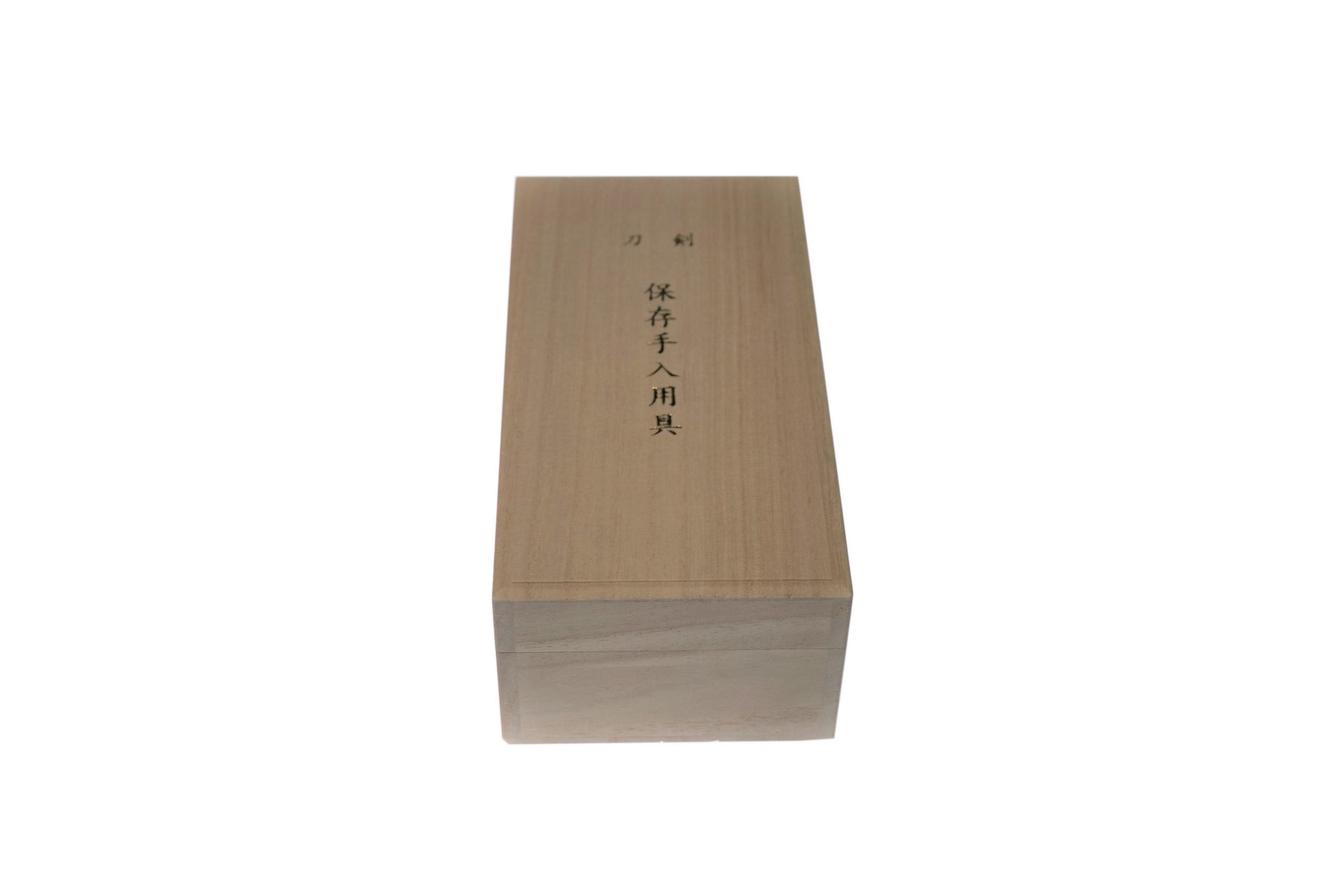
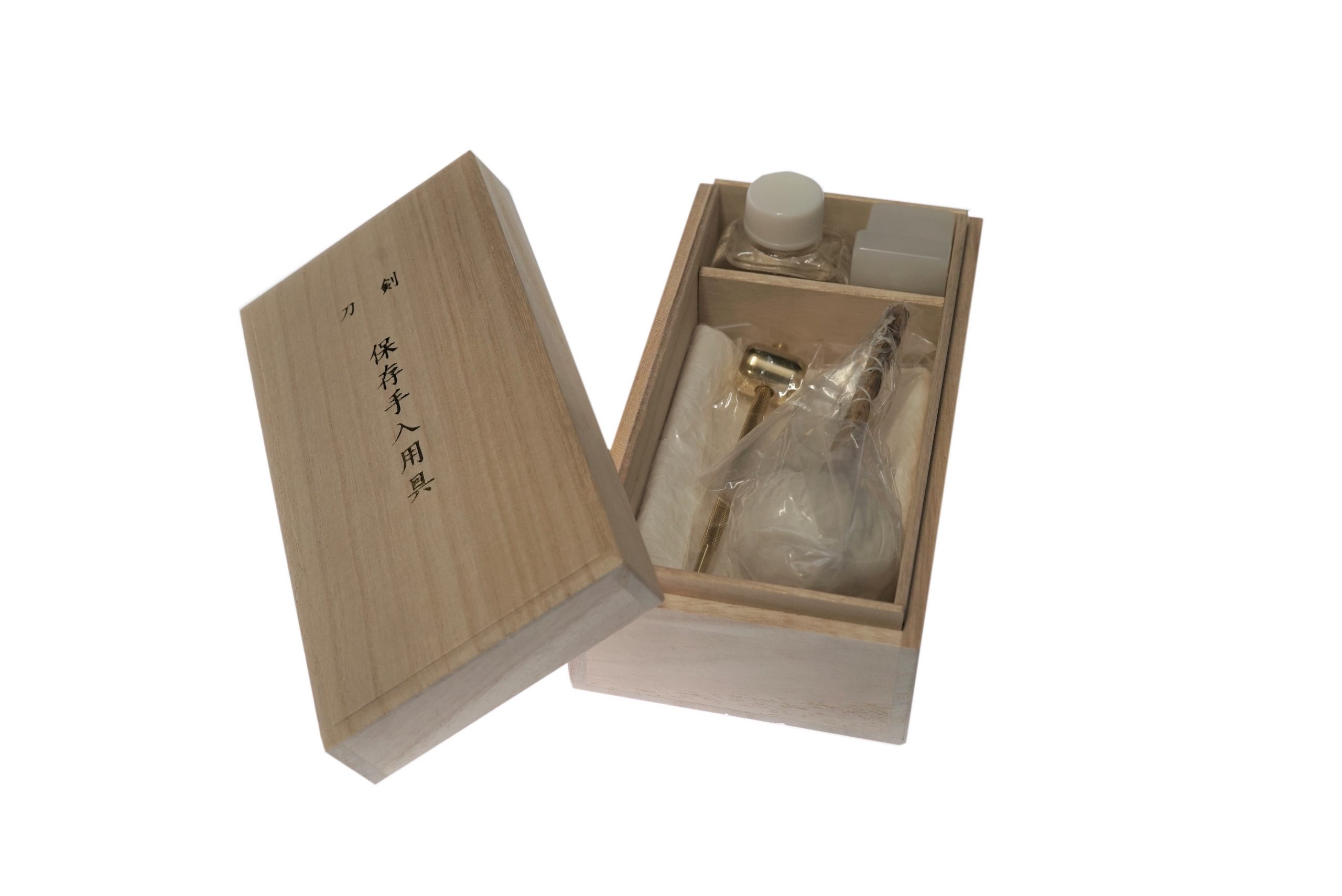
MORE ANTIQUE JAPANESE SWORD FOR SALE
SWORDS WITHOUT CERTIFICATES FOR SALE
LEARN JAPANESE SWORD TERMINOLOGY
Thank you for reading all the information on the page. If you have any difficulty choosing the right Japanese sword for you, we will be more than happy to help you find the one that speaks to you the most. Please feel free to contact us.
